
Felix Janus; Nicolas S. Beermann; Amir Khan; Jyoti Yadav; Reshma Rajeev Lekha; Wentao Zhang; Hassan A. Hafez; Dmitry Turchinovich; Markus Meinert
Enhanced THz emission from spintronic emitters with Pt-Al alloys Journal Article
In: Appl. Phys. Lett., vol. 127, 152406, 2025.
@article{Janus2025b,
title = {Enhanced THz emission from spintronic emitters with Pt-Al alloys},
author = {Felix Janus and Nicolas S. Beermann and Amir Khan and Jyoti Yadav and Reshma Rajeev Lekha and Wentao Zhang and Hassan A. Hafez and Dmitry Turchinovich and Markus Meinert},
doi = {10.1063/5.0294491},
year = {2025},
date = {2025-10-14},
journal = {Appl. Phys. Lett.},
volume = {127, 152406},
abstract = {Platinum (Pt) is the element with the largest spin Hall conductivity and is known as the most efficient spin-to-charge conversion material in spintronic THz emitters. By alloying with aluminum (Al), its resistivity can be substantially increased, exceeding 100 lX cm. While the spin Hall conductivity is reduced by alloying, the relative resistivity increase surpasses the reduction of spin Hall conductivity, thereby enhances the spin Hall angle. We make use of this mechanism to improve the commonly used Pt-based spintronic THz emitter and demonstrate that an increase of 67% in the THz emission amplitude can be achieved between 20% and 30% Al in Pt. We show that the enhanced THz emission amplitude is driven by the enhanced multilayer impedance due to the larger resistivity.},
keywords = {},
pubstate = {published},
tppubtype = {article}
}

Yuhao Meng; Jian-Fen Wang; Matthias Weiling; Wentao Zhang; Felix Pfeiffer; Lukas Goett-Zink; Tilman Kottke; Jijeesh Ravi Nair; Masoud Baghernejad; Dmitry Turchinovich; Hassan A. Hafez
In: J. Chem. Phys., vol. 163(14), 144903, 2025.
@article{Meng2025,
title = {Comprehensive optical spectroscopy of solid-state polymer electrolytes: Harmonic and anharmonic vibrational activity and charge dynamics from terahertz to ultraviolet},
author = {Yuhao Meng and Jian-Fen Wang and Matthias Weiling and Wentao Zhang and Felix Pfeiffer and Lukas Goett-Zink and Tilman Kottke and Jijeesh Ravi Nair and Masoud Baghernejad and Dmitry Turchinovich and Hassan A. Hafez},
doi = {10.1063/5.0289402},
year = {2025},
date = {2025-10-10},
journal = {J. Chem. Phys.},
volume = {163(14), 144903},
abstract = {We investigate the vibrational and electronic properties of solid-state polymer electrolytes (SPEs) using optical spectroscopy spanning an ultrabroadband range of frequencies extending from terahertz (THz) to ultraviolet (UV). The employed techniques include THz time-domain spectroscopy (THz-TDS), Fourier-transform infrared spectroscopy, and photometric IR–UV spectroscopy. Our study demonstrates that incorporating salts into the host polymer matrix to form an electrolyte gives rise to characteristic optical properties of SPEs, depending on the type, content, and concentration of the added salt, which we describe as follows. In the THz range, distinctive absorption bands are observed, which we attribute to THz-resonant vibrations of polymer chains. In contrast, sharp resonant absorption bands and lines due to IR-active vibrations of chemical bonds (inter- and intra-molecular vibrations) within the polymer chains and lithium salts are observed in the IR range. Density functional theory calculations were performed to provide insight into these vibrational properties of SPEs and helped to assign the relevant vibrational modes. In the UV range, we focus on characterizing the energy gap associated with transitions from bonding to antibonding states. Optical spectroscopy, as a powerful noninvasive characterization tool, thus provides valuable insights into the charge and molecular dynamics in SPEs. These insights are crucial for their technological applications and can support chemistry-based efforts to improve the properties of SPEs.},
keywords = {},
pubstate = {published},
tppubtype = {article}
}
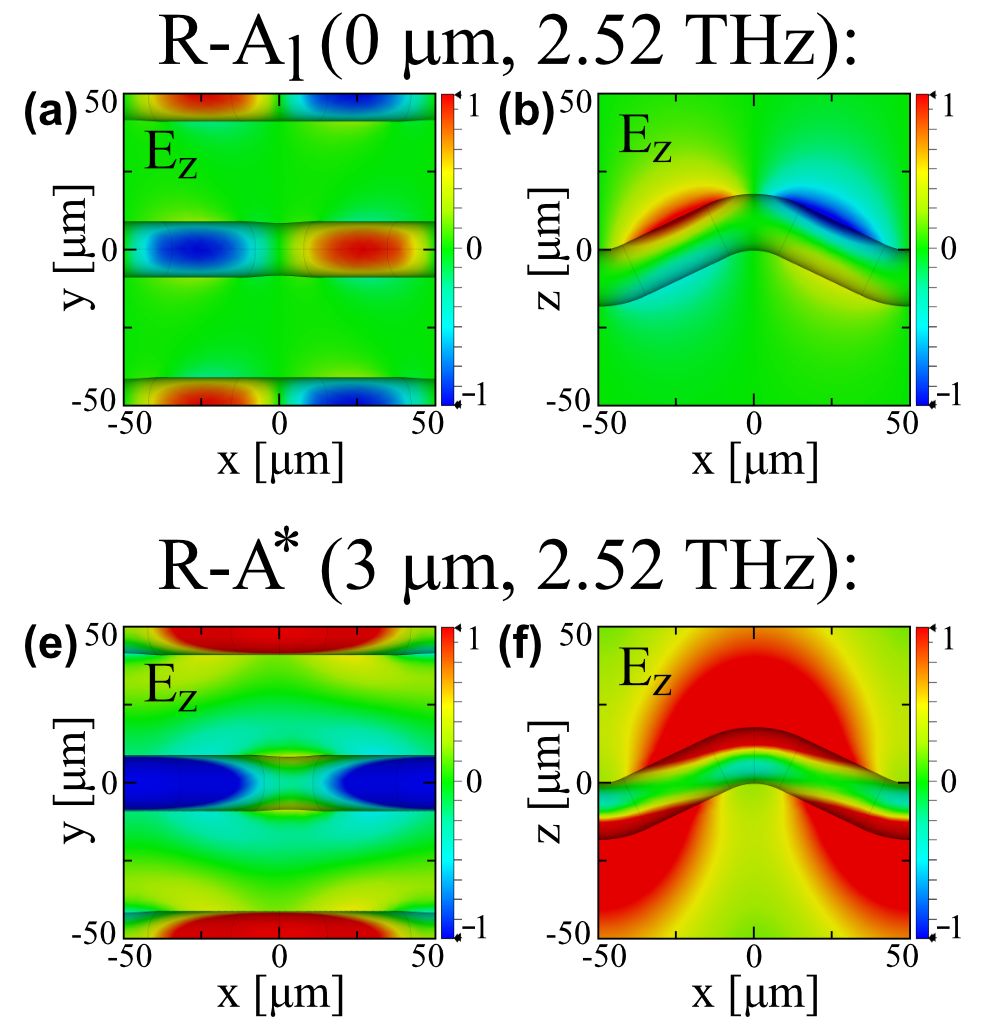
Simon Rossel; Wentao Zhang; Hassan A. Hafez; Savio Fabretti; Dmitry Turchinovich
Plasmonic mode coupling in three-dimensional metallic wire terahertz metamaterials Journal Article
In: Opt. Express, vol. 33(15), pp. 32320-32332, 2025.
@article{Rossel2025,
title = {Plasmonic mode coupling in three-dimensional metallic wire terahertz metamaterials},
author = {Simon Rossel and Wentao Zhang and Hassan A. Hafez and Savio Fabretti and Dmitry Turchinovich},
doi = {10.1364/OE.568464},
year = {2025},
date = {2025-07-23},
journal = {Opt. Express},
volume = {33(15)},
pages = {32320-32332},
abstract = {In this paper, we numerically investigate the plasmonic properties of three-dimensional metallic wire-based terahertz (THz) metamaterials, with the aim of elucidating the plasmonic mode coupling within these structures. Two structures are examined: a metallic bent wire array and a woven wire mesh composed of two interwoven metallic wire arrays. Despite being composed of simple metallic wires, both systems exhibit intricate plasmonic behavior arising from the coupling of THz surface plasmon polariton (SPP) modes on the individual wires. In the bent wire array, the SPP coupling gives rise to a bound state in the continuum, and under strong coupling conditions, the system transitions to localized plasmonic modes with field enhancement factors approaching ∼103. In the woven wire mesh, the plasmonic coupling extends to the orthogonally oriented wires, enabling effective cross-guide directional coupling of wire SPPs. These results highlight the versatility of wire-based structures for applications such as THz plasmonic waveguiding, frequency filtering, and field enhancement.},
keywords = {},
pubstate = {published},
tppubtype = {article}
}
Tomoki Hiraoka; Sandra Nestler; Wentao Zhang; Simon Rossel; Hassan A. Hafez; Savio Fabretti; Heike Schlörb; Andy Thomas; Dmitry Turchinovich
Terahertz field effect in a two-dimensional semiconductor Journal Article
In: Nat. Commun., vol. 16, 5235, 2025.
@article{Hiraoka2025,
title = {Terahertz field effect in a two-dimensional semiconductor},
author = {Tomoki Hiraoka and Sandra Nestler and Wentao Zhang and Simon Rossel and Hassan A. Hafez and Savio Fabretti and Heike Schlörb and Andy Thomas and Dmitry Turchinovich },
doi = {https://doi.org/10.1038/s41467-025-60588-6},
year = {2025},
date = {2025-06-05},
journal = {Nat. Commun.},
volume = {16, 5235},
abstract = {Layered two-dimensional (2D) materials offer many promising avenues for advancing modern electronics, thanks to their tunable optical, electronic, and magnetic properties. Applying a strong electric field perpendicular to the layers, typically at the MV/cm level, is a highly effective way to control these properties. However, conventional methods to induce such fields employ electric circuit - based gating techniques, which are restricted to microwave response rates and face challenges in achieving device-compatible ultrafast, sub-picosecond control. Here, we demonstrate an ultrafast field effect in atomically thin MoS2 embedded within a hybrid 3D-2D terahertz nanoantenna. This nanoantenna transforms an incoming terahertz electric field into a vertical ultrafast gating field in MoS2, simultaneously enhancing it to the MV/cm level. The terahertz field effect is observed as a coherent terahertz-induced Stark shift of exciton resonances in MoS2. Our results offer a promising strategy to tune and operate ultrafast optoelectronic devices based on 2D materials.},
keywords = {},
pubstate = {published},
tppubtype = {article}
}

Felix Janus; Jyoti Yadav; Nicolas S. Beermann; Wentao Zhang; Hassan A. Hafez; Dmitry Turchinovich; Sascha Preu; Markus Meinert
Emergent spin Hall conductivity in tantalum-rhenium alloys Journal Article
In: Phys. Rev. B, vol. 111(17), 174411, 2025.
@article{Janus2025,
title = {Emergent spin Hall conductivity in tantalum-rhenium alloys},
author = {Felix Janus and Jyoti Yadav and Nicolas S. Beermann and Wentao Zhang and Hassan A. Hafez and Dmitry Turchinovich and Sascha Preu and Markus Meinert},
doi = {10.1103/PhysRevB.111.174411},
year = {2025},
date = {2025-05-07},
journal = {Phys. Rev. B},
volume = {111(17), 174411},
abstract = {We investigate the spin Hall conductivity (SHC) of a composition series of a Ta-Re bcc solid solution. At approximately 60 at.% Ta the Ta-Re alloy features a SHC similar to bcc-W, while both endpoints of the compositional series have rather moderate SHC. The intermediate stoichiometries exhibit a substantial enhancement due to Fermi-level tuning through the same band structure feature which gives bcc-W and β-W its large SHC. We provide experimental evidence for the enhancement of the SHC in the alloy via THz emission upon ultrafast laser excitation of Ta-Re/CoFeB bilayers. We demonstrate that a rigid-band model derived from bcc-W and Fermi-level tuning describes the experimental data with a similar accuracy as the coherent-potential approximation alloy calculations of the SHC.},
keywords = {},
pubstate = {published},
tppubtype = {article}
}
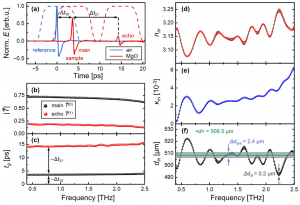
Nicolas S. Beermann; Andreas Gebauer; Savio Fabretti; Wentao Zhang; Tomoki Hiraoka; Alexander W. Achtstein; Hassan A. Hafez; Dmitry Turchinovich
Terahertz time-domain spectroscopy for simultaneous measurement of optical constants, and material thickness with deep-subwavelength precision Journal Article
In: Opt. Express, vol. 33(4), pp. 8650-8660, 2025.
@article{Beermann2025,
title = {Terahertz time-domain spectroscopy for simultaneous measurement of optical constants, and material thickness with deep-subwavelength precision},
author = {Nicolas S. Beermann and Andreas Gebauer and Savio Fabretti and Wentao Zhang and Tomoki Hiraoka and Alexander W. Achtstein and Hassan A. Hafez and Dmitry Turchinovich},
url = {https://www.turchinovich-lab.de/wp-content/uploads/2025/03/ERTS-method.zip},
doi = {10.1364/OE.544182},
year = {2025},
date = {2025-02-24},
journal = {Opt. Express},
volume = {33(4)},
pages = { 8650-8660},
abstract = {We present a method of terahertz time-domain spectroscopy (THz-TDS) in transmission configuration, which allows one to obtain the frequency-resolved complex-valued optical constants of the material, and to simultaneously determine the thickness of the investigated material sample with sub-micrometer precision. The thickness estimation achieves deep-subwavelength precision of the order of λ/1000. Our method is based on the numerical solution of transcendental transmission equations of Fourier-transformed main and echo THz pulses. It can be universally applied to materials with arbitrary absorption and refractive index dispersion as long as the echo THz signal in transmission is clearly discernible. As a first demonstration, several common dielectric materials such as MgO, Al2O3, GaAs, and SiO2 were characterized. We also demonstrate that the conventionally employed THz time-of-flight thickness measurement approach leads to a systematic error when applied to absorptive materials.},
keywords = {},
pubstate = {published},
tppubtype = {article}
}
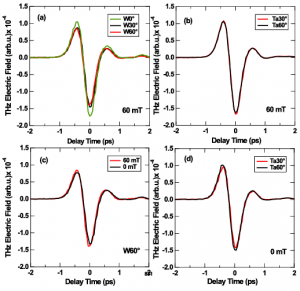
Amir Khan; Nicolas Sylvester Beermann; Shalini Sharma; Tiago de Oliveira Schneider; Wentao Zhang; Dmitry Turchinovich; Markus Meinert
Efficient spintronic THz emitters without external magnetic field Journal Article
In: Appl. Phys. Lett. , vol. 126, no. 032403, 2025.
@article{Khan2025,
title = {Efficient spintronic THz emitters without external magnetic field},
author = {Amir Khan and Nicolas Sylvester Beermann and Shalini Sharma and Tiago de Oliveira Schneider and Wentao Zhang and Dmitry Turchinovich and Markus Meinert},
doi = {10.1063/5.0247998},
year = {2025},
date = {2025-01-23},
journal = {Appl. Phys. Lett. },
volume = {126},
number = {032403},
abstract = {We investigate the performance of state-of-the-art spintronic THz emitters (W or Ta)/CoFeB/Pt with non-magnetic underlayer deposited using oblique angle deposition. The THz emission amplitude in the presence or absence of an external magnetic field remains the same and remarkably stable over time. This stability is attributed to the enhanced uniaxial magnetic anisotropy in the ferromagnetic layer, achieved by the oblique angle deposition of the underlying non-magnetic layer. Our findings could be used for the development of practical field-free emitters of linearly polarized THz radiation, potentially enabling applications in future THz technologies.},
keywords = {},
pubstate = {published},
tppubtype = {article}
}
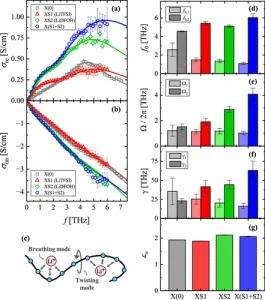
Johanna Weidelt; Jijeesh Ravi Nair; Diddo Diddens; Wentao Zhang; Felix Pfeiffer; Tiago de Oliveira Schneider; Markus Meinert; Tomoki Hiraoka; Linda Nesterov; Masoud Baghernejad; Dmitry Turchinovich; Hassan A. Hafez
Fundamental Picture of the Conduction Mechanism in Solid-State Polymer Electrolytes Revealed by Terahertz Spectroscopy Journal Article
In: J. Phys.Chem.C, vol. 128, pp. 6868, 2024.
@article{Weidelt2024,
title = {Fundamental Picture of the Conduction Mechanism in Solid-State Polymer Electrolytes Revealed by Terahertz Spectroscopy},
author = {Johanna Weidelt and Jijeesh Ravi Nair and Diddo Diddens and Wentao Zhang and Felix Pfeiffer and Tiago de Oliveira Schneider and Markus Meinert and Tomoki Hiraoka and Linda Nesterov and Masoud Baghernejad and Dmitry Turchinovich and Hassan A. Hafez},
doi = {10.1021/acs.jpcc.4c00232},
year = {2024},
date = {2024-03-12},
journal = {J. Phys.Chem.C},
volume = {128},
pages = {6868},
abstract = {Solid polymer electrolytes (SPEs) based on cross-linked poly(ethylene oxide) encompassing lithium salts have gained significant attention as separators in solid-state lithium metal batteries. Here, we employ terahertz time-domain spectroscopy (THz-TDS), as a noninvasive contact-free technique, to investigate the conduction properties of these cross-linked SPEs and unravel their dependencies on the added lithium salt and the sample temperature. The obtained THz conductivity spectra are dominated by THz absorption bands, which we attribute to resonant vibrations within the polymer matrix of the electrolyte. By careful application of the Lorentz model, the conductivity spectra have been analyzed, and the relevant polymer vibration modes have been quantitatively assessed. Calculations based on density functional theory were performed to elucidate the possible microscopic mechanisms of these resonant vibrations. This study sheds light on the relevance of polymer matrix vibrations validating the hopping transport of lithium ions in SPEs which ultimately leads to the technologically relevant ionic conduction in solid-state polymer-based electrolytes.},
keywords = {},
pubstate = {published},
tppubtype = {article}
}
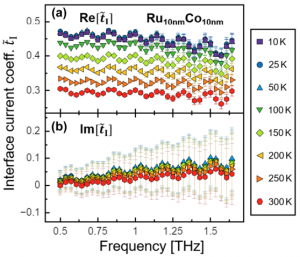
Nicolas S Beermann; Savio Fabretti; Hassan A Hafez; Maria-Andromachi Syskaki; Iryna Kononenko; Gerhard Jakob; Mathias Kläui; Dmitry Turchinovich
In: Nanophotonics, vol. 31, pp. 1883, 2024.
@article{Beermann2024,
title = {Electronic transparency of internal interfaces in metallic nanostructures comprising light, heavy and ferromagnetic metals measured by terahertz spectroscopy},
author = {Nicolas S Beermann and Savio Fabretti and Hassan A Hafez and Maria-Andromachi Syskaki and Iryna Kononenko and Gerhard Jakob and Mathias Kläui and Dmitry Turchinovich},
doi = {https://doi.org/10.1515/nanoph-2023-0721},
year = {2024},
date = {2024-01-15},
journal = {Nanophotonics},
volume = {31},
pages = {1883},
abstract = {We investigate the electronic transport at the internal interface within a selection of metallic bilayer nanostructures using the contact-free, all-optical method of THz time-domain spectroscopy. The Ru/Co, Ru/Pt, and Ru/Al bilayer nanostructures and their individual constituent metals are studied, with Ru representing an archetypal d-band metal, Co an archetypal ferromagnet, and Pt and Al archetypal heavy and light metals, respectively. The THz conductivity data were analyzed in terms of Drude and Bloch–Grüneisen models, and the interface current coefficient of the internal nanointerface was determined. Strong temperature dependency of the interface current coefficient in the Ru/Co nanostructure is revealed.},
keywords = {},
pubstate = {published},
tppubtype = {article}
}
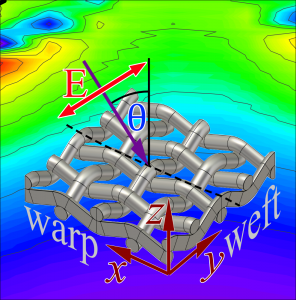
Simon Rossel; Wentao Zhang; Hassan A Hafez; Savio Fabretti; Dmitry Turchinovich
Efficient terahertz optical filtering with large-area all-metal and polymer-metal woven wire meshes Journal Article
In: Opt. Express, vol. 31, pp. 19076, 2023.
@article{Rossel2023,
title = {Efficient terahertz optical filtering with large-area all-metal and polymer-metal woven wire meshes},
author = {Simon Rossel and Wentao Zhang and Hassan A Hafez and Savio Fabretti and Dmitry Turchinovich},
url = {https://opg.optica.org/oe/fulltext.cfm?uri=oe-31-12-19076&id=530907},
doi = {10.1364/OE.490078},
year = {2023},
date = {2023-05-24},
journal = {Opt. Express},
volume = {31},
pages = {19076},
abstract = {Many components for terahertz (THz) optical filtering are mechanically fragile and are hard to produce with large aperture, making them unsuitable for applications where larger THz beam diameter is required. In this work, the THz optical properties of industrial-grade, readily available and inexpensive woven wire meshes are studied using THz time-domain spectroscopy and numerical simulations. These meshes are meter-sized, free-standing sheet materials that are principally attractive for the use as robust, large-area THz components. Our results show that such meshes can act as efficient, tunable THz bandpass filters due to sharp plasmonic resonance supported by the interwoven metallic wires. Further, the meshes that combine metallic and polymer wires act as efficient THz linear polarizers with a polarization extinction ratio (field) above 60:1 for frequencies below 3 THz.
© 2023 Optica Publishing Group under the terms of the Optica Open Access Publishing Agreement},
keywords = {},
pubstate = {published},
tppubtype = {article}
}
© 2023 Optica Publishing Group under the terms of the Optica Open Access Publishing Agreement
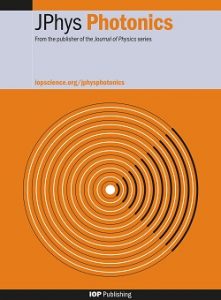
Nathalie Vermeulen; Daniel Espinosa; Adam Ball; John M Ballato; Phillippe Boucaud; Georges Boudebs; Cecília L A V Campos; Peter D Dragic; Anderson Gomes; Mikko J Huttunen; Nathaniel Kinsey; R P Mildren; Dragomir Neshev; Lázaro Padilha; Minhao Pu; Ray Secondo; Eiji Tokunaga; Dmitry Turchinovich; Jingshi Yan; Kresten Yvind; Ksenia Dolgaleva; E van Stryland
Post-2000 nonlinear optical materials and measurements: Data tables and best practices Journal Article
In: J. Phys. Photonics, vol. 5, pp. 035001, 2023.
@article{Vermeulen2022,
title = {Post-2000 nonlinear optical materials and measurements: Data tables and best practices},
author = {Nathalie Vermeulen and Daniel Espinosa and Adam Ball and John M Ballato and Phillippe Boucaud and Georges Boudebs and Cecília L A V Campos and Peter D Dragic and Anderson Gomes and Mikko J Huttunen and Nathaniel Kinsey and R P Mildren and Dragomir Neshev and Lázaro Padilha and Minhao Pu and Ray Secondo and Eiji Tokunaga and Dmitry Turchinovich and Jingshi Yan and Kresten Yvind and Ksenia Dolgaleva and E van Stryland},
url = {https://iopscience.iop.org/article/10.1088/2515-7647/ac9e2f},
doi = {10.1088/2515-7647/ac9e2f},
year = {2023},
date = {2023-05-17},
journal = {J. Phys. Photonics},
volume = {5},
pages = {035001},
abstract = {In its 60 years of existence, the field of nonlinear optics has gained momentum especially over the past two decades thanks to major breakthroughs in material science and technology. In this article, we present a new set of data tables listing nonlinear-optical properties for different material categories as reported in the literature since 2000. The papers included in the data tables are representative experimental works on bulk materials, solvents, 0D-1D-2D materials, metamaterials, fiber waveguiding materials, on-chip waveguiding materials, hybrid waveguiding systems, and materials suitable for nonlinear optics at THz frequencies. In addition to the data tables, we also provide best practices for performing and reporting nonlinear-optical experiments. These best practices underpin the selection process that was used for including papers in the tables. While the tables indeed show strong advancements in the field over the past two decades, we encourage the nonlinear-optics community to implement the identified best practices in future works. This will allow a more adequate comparison, interpretation and use of the published parameters, and as such further stimulate the overall progress in nonlinear-optical science and applications},
keywords = {},
pubstate = {published},
tppubtype = {article}
}
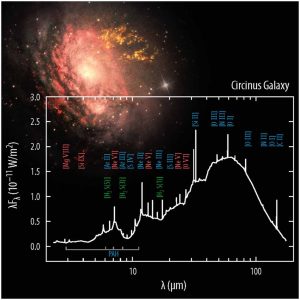
Alfred Leitenstorfer; Andrey S. Moskalenko; Tobias Kampfrath; Junichiro Kono; Enrique Castro-Camus; Kun Peng; Naser Qureshi; Dmitry Turchinovich; Koichiro Tanaka; Andrea Markelz; Martina Havenith; Cameron Hough; Hannah J Joyce; Willie Padilla; Binbin Zhou; Ki-Yong Kim; Xi-Cheng Zhang; Peter Uhd Jepsen; Sukhdeep Dhillon; Miriam Serena Vitiello; Edmund H Linfield; Alexander Giles Davies; Matthias Hoffmann; Roger Lewis; Masayoshi Tonouchi; Pernille Klarskov; Tom Seifert; Yaroslav Gerasimenko; Dragan D Mihailovic; Rupert Huber; Jessica Boland; Oleg Mitrofanov; Paul Dean; Brian Ellison; Peter Huggard; Simon Rea; Christopher Walker; David Leisawitz; Jian Rong Gao; Chong Li; Qin Chen; Gintaras Valusis; Vincent Patrick Wallace; Emma MacPherson; Xiaobang Shang; Jeffrey Hesler; Nick Ridler; Cyril Renaud; Ingmar Kallfass; Tadao Nagatsuma; Axel Zeitler; Don Arnone; Michael Johnston; John Cunningham
The 2023 Terahertz Science and Technology Roadmap Journal Article
In: J. Phys. D: Appl. Phys., vol. 56, pp. 2230001, 2023.
@article{Leitenstorfer2023,
title = {The 2023 Terahertz Science and Technology Roadmap},
author = {Alfred Leitenstorfer and Andrey S. Moskalenko and Tobias Kampfrath and Junichiro Kono and Enrique Castro-Camus and Kun Peng and Naser Qureshi and Dmitry Turchinovich and Koichiro Tanaka and Andrea Markelz and Martina Havenith and Cameron Hough and Hannah J Joyce and Willie Padilla and Binbin Zhou and Ki-Yong Kim and Xi-Cheng Zhang and Peter Uhd Jepsen and Sukhdeep Dhillon and Miriam Serena Vitiello and Edmund H Linfield and Alexander Giles Davies and Matthias Hoffmann and Roger Lewis and Masayoshi Tonouchi and Pernille Klarskov and Tom Seifert and Yaroslav Gerasimenko and Dragan D Mihailovic and Rupert Huber and Jessica Boland and Oleg Mitrofanov and Paul Dean and Brian Ellison and Peter Huggard and Simon Rea and Christopher Walker and David Leisawitz and Jian Rong Gao and Chong Li and Qin Chen and Gintaras Valusis and Vincent Patrick Wallace and Emma MacPherson and Xiaobang Shang and Jeffrey Hesler and Nick Ridler and Cyril Renaud and Ingmar Kallfass and Tadao Nagatsuma and Axel Zeitler and Don Arnone and Michael Johnston and John Cunningham},
url = {https://iopscience.iop.org/article/10.1088/1361-6463/acbe4c},
doi = {10.1088/1361-6463/acbe4c},
year = {2023},
date = {2023-04-05},
journal = {J. Phys. D: Appl. Phys.},
volume = {56},
pages = {2230001},
abstract = {Terahertz (THz) radiation encompasses a wide spectral range within the electromagnetic spectrum that extends from microwaves to the far infrared (100 GHz to ~30 THz). Within its frequency boundaries exist a broad variety of scientific disciplines that have presented, and continue to present, technical challenges to researchers. During the past 50 years, for instance, the demands of the scientific community have substantially evolved and with a need for advanced instrumentation to support radio astronomy, Earth observation, weather forecasting, security imaging, telecommunications, non-destructive device testing and much more. Furthermore, applications have required an emergence of technology from the laboratory environment to production-scale supply and in-the-field deployments ranging from harsh ground-based locations to deep space. In addressing these requirements, the research and development community has advanced related technology and bridged the transition between electronics and photonics that high frequency operation demands. The multidisciplinary nature of THz work was our stimulus for creating the 2017 THz Science and Technology Roadmap (S S Dhillon et al 2017 J. Phys. D: Appl. Phys. 50 043001). As one might envisage, though, there remains much to explore both scientifically and technically and the field has continued to develop and expand rapidly. It is timely, therefore, to revise our previous roadmap and in this 2023 version we both provide an update on key developments in established technical areas that have important scientific and public benefit, and highlight new and emerging areas that show particular promise. The developments that we describe thus span from fundamental scientific research, such as THz astronomy and the emergent area of THz quantum optics, to highly applied and commercially and societally impactful subjects that include 6G THz communications, medical imaging, and climate monitoring and prediction.},
keywords = {},
pubstate = {published},
tppubtype = {article}
}
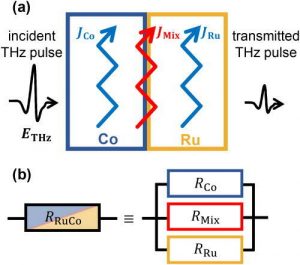
Nicolas S Beermann; Savio Fabretti; Karsten Rott; Hassan A Hafez; Günter Reiss; Dmitry Turchinovich
Disentangling complex current pathways in a metallic Ru/Co bilayer nanostructure using THz spectroscopy Journal Article
In: Appl. Phys. Lett., vol. 121, pp. 203101, 2022.
@article{Beermann2022,
title = {Disentangling complex current pathways in a metallic Ru/Co bilayer nanostructure using THz spectroscopy},
author = {Nicolas S Beermann and Savio Fabretti and Karsten Rott and Hassan A Hafez and Günter Reiss and Dmitry Turchinovich},
url = {https://aip.scitation.org/doi/full/10.1063/5.0125464},
doi = {10.1063/5.0125464},
year = {2022},
date = {2022-11-15},
journal = {Appl. Phys. Lett.},
volume = {121},
pages = {203101},
abstract = {Many modern spintronic technologies, such as spin valves, spin Hall applications, and spintronic THz emitters, are based on electrons crossing buried internal interfaces within metallic nanostructures. However, the complex current pathways within such nanostructures are difficult to disentangle using conventional experimental methods. Here, we measure the conductivity of a technologically relevant Ru/Co bilayer nanostructure in a contact-free fashion using THz time-domain spectroscopy. By applying an effective resistor network to the data, we resolve the complex current pathways within the nanostructure and determine the degree of electronic transparency of the internal interface between the Ru and Co nanolayers.
The authors acknowledge the financial support from the European Union's Horizon 2020 research and innovation programme (Grant Agreement No. 964735 EXTREME-IR) and Deutsche Forschungsgemeinschaft (DFG) within Project No. 468501411-SPP2314 INTEGRATECH under the framework of the priority programme SPP2314-INTEREST.},
keywords = {},
pubstate = {published},
tppubtype = {article}
}
The authors acknowledge the financial support from the European Union's Horizon 2020 research and innovation programme (Grant Agreement No. 964735 EXTREME-IR) and Deutsche Forschungsgemeinschaft (DFG) within Project No. 468501411-SPP2314 INTEGRATECH under the framework of the priority programme SPP2314-INTEREST.
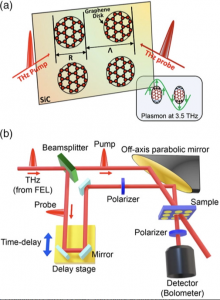
Jeong Woo Han; Matthew L Chin; Sebastian Matschy; Jayaprakash Poojali; Angelika Seidl; Stephan Winnerl; Hassan A Hafez; Dmitry Turchinovich; Gagan Kumar; Rachael L Myers-Ward; Matthew T Dejarld; Kevin M Daniels; Howard Dennis Drew; Thomas E Murphy; Martin Mittendorff
Plasmonic Terahertz Nonlinearity in Graphene Disks Journal Article
In: Adv. Photonics Res., vol. 3, pp. 2100218, 2021.
@article{Han2021,
title = {Plasmonic Terahertz Nonlinearity in Graphene Disks},
author = {Jeong Woo Han and Matthew L Chin and Sebastian Matschy and Jayaprakash Poojali and Angelika Seidl and Stephan Winnerl and Hassan A Hafez and Dmitry Turchinovich and Gagan Kumar and Rachael L Myers-Ward and Matthew T Dejarld and Kevin M Daniels and Howard Dennis Drew and Thomas E Murphy and Martin Mittendorff},
doi = {10.1002/adpr.202100218},
year = {2021},
date = {2021-12-18},
journal = {Adv. Photonics Res.},
volume = {3},
pages = {2100218},
abstract = {The discovery of graphene and its unique optical and electronic properties has triggered intense developments in a vast number of optoelectronic applications, especially in spectral regions that are not easily accessible with conventional semiconductors. Particularly in the THz regime, where the free-carrier interaction with low-energetic photons usually dominates, detectors and modulators based on graphene often feature an improved response time. Nevertheless, the light−matter interaction suffers from the small interaction volume. One way to enhance the efficiency of such devices at elevated frequencies is by patterning graphene into plasmonic structures like disks. In addition to the increased linear absorption, the plasmon resonance also creates a strong, surface-localized field that enhances the nonlinear optical response. While experimental studies so far have focused on hot carrier effects, theoretical studies also suggest an increase in the nonlinearity beyond thermal effects. Herein, polarization-dependent pump-probe measurements on graphene disks that disentangle the contributions of thermal and plasmonic nonlinearity are presented. An increase in the pump-induced transmission is observed when pump and probe radiation are copolarized. To further elucidate the interplay of thermal and plasmonic effects, a model that supports the origin of the polarization-dependent enhancement of the observed THz nonlinearities is developed.},
keywords = {},
pubstate = {published},
tppubtype = {article}
}
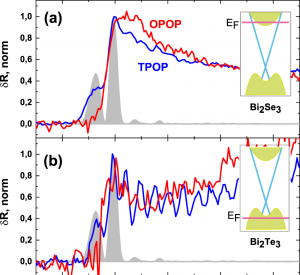
S Kovalev; K -J Tielrooij; J -C Deinert; I Ilyakov; N Awari; M Chen; A Ponomaryov; M Bawatna; T V A G de Oliveira; L M Eng; K A Kuznetsov; D A Safronenkov; Kh. G Kitaeva; P I Kuznetsov; H A Hafez; D Turchinovich; M Gensch
Terahertz signatures of ultrafast Dirac fermion relaxation at the surface of topological insulators Journal Article
In: npj Quantum Mater., vol. 6, pp. 84, 2021.
@article{Kovalev2021b,
title = {Terahertz signatures of ultrafast Dirac fermion relaxation at the surface of topological insulators},
author = {S Kovalev and K -J Tielrooij and J -C Deinert and I Ilyakov and N Awari and M Chen and A Ponomaryov and M Bawatna and T V A G de Oliveira and L M Eng and K A Kuznetsov and D A Safronenkov and Kh. G Kitaeva and P I Kuznetsov and H A Hafez and D Turchinovich and M Gensch},
url = {https://www.nature.com/articles/s41535-021-00384-9#article-info},
doi = {10.1038/s41535-021-00384-9},
year = {2021},
date = {2021-10-01},
journal = {npj Quantum Mater.},
volume = {6},
pages = {84},
abstract = {Topologically protected surface states present rich physics and promising spintronic, optoelectronic, and photonic applications that require a proper understanding of their ultrafast carrier dynamics. Here, we investigate these dynamics in topological insulators (TIs) of the bismuth and antimony chalcogenide family, where we isolate the response of Dirac fermions at the surface from the response of bulk carriers by combining photoexcitation with below-bandgap terahertz (THz) photons and TI samples with varying Fermi level, including one sample with the Fermi level located within the bandgap. We identify distinctly faster relaxation of charge carriers in the topologically protected Dirac surface states (few hundred femtoseconds), compared to bulk carriers (few picoseconds). In agreement with such fast cooling dynamics, we observe THz harmonic generation without any saturation effects for increasing incident fields, unlike graphene which exhibits strong saturation. This opens up promising avenues for increased THz nonlinear conversion efficiencies, and high-bandwidth optoelectronic and spintronic information and communication applications.},
keywords = {},
pubstate = {published},
tppubtype = {article}
}
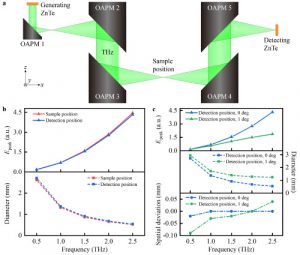
W Zhang; D Turchinovich
Rigorous signal reconstruction in terahertz emission spectroscopy Journal Article
In: Opt. Express, vol. 15, pp. 24411, 2021.
@article{Zhang2021,
title = {Rigorous signal reconstruction in terahertz emission spectroscopy},
author = {W Zhang and D Turchinovich},
doi = {10.1364/OE.431739},
year = {2021},
date = {2021-07-16},
urldate = {2021-07-16},
journal = {Opt. Express},
volume = {15},
pages = {24411},
abstract = {Terahertz (THz) emission spectroscopy is a powerful method that allows one to measure the ultrafast dynamics of polarization, current, or magnetization in a material based on THz emission from the material. However, the practical implementation of this method can be challenging, and can result in significant errors in the reconstruction of the quantity of interest. Here, we experimentally and theoretically demonstrate a rigorous method of signal reconstruction in THz emission spectroscopy, and describe the main experimental and theoretical sources of reconstruction error. We identify the linear line-of-sight geometry of the THz emission spectrometer as the optimal configuration for accurate, fully calibrated THz signal reconstruction. As an example, we apply our reconstruction method to ultrafast THz magnetometry experiment, where we recover the ultrafast magnetization dynamics in a photoexcited iron film, including both its temporal shape and absolute magnitude.
© 2021 Optical Society of America under the terms of the OSA Open Access Publishing Agreement},
keywords = {},
pubstate = {published},
tppubtype = {article}
}
© 2021 Optical Society of America under the terms of the OSA Open Access Publishing Agreement
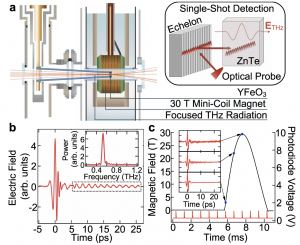
T Makihara; K Hayashida; Noe G T II; X Li; N M Peraca; X Ma; Z Jin; W Ren; G Ma; I Katayama; J Takeda; H Nojiri; D Turchinovich; S Cao; M Bamba; J Kono
Ultrastrong magnon–magnon coupling dominated by antiresonant interactions Journal Article
In: Nature Communications, vol. 12, pp. 3315, 2021.
@article{Makihara2021,
title = {Ultrastrong magnon–magnon coupling dominated by antiresonant interactions},
author = {T Makihara and K Hayashida and Noe G T II and X Li and N M Peraca and X Ma and Z Jin and W Ren and G Ma and I Katayama and J Takeda and H Nojiri and D Turchinovich and S Cao and M Bamba and J Kono},
doi = {10.1038/s41467-021-23159-z},
year = {2021},
date = {2021-05-25},
journal = {Nature Communications},
volume = {12},
pages = {3315},
abstract = {Exotic quantum vacuum phenomena are predicted in cavity quantum electrodynamics systems with ultrastrong light-matter interactions. Their ground states are predicted to be vacuum squeezed states with suppressed quantum fluctuations owing to antiresonant terms in the Hamiltonian. However, such predictions have not been realized because antiresonant interactions are typically negligible compared to resonant interactions in light-matter systems. Here we report an unusual, ultrastrongly coupled matter-matter system of magnons that is analytically described by a unique Hamiltonian in which the relative importance of resonant and antiresonant interactions can be easily tuned and the latter can be made vastly dominant. We found a regime where vacuum Bloch-Siegert shifts, the hallmark of antiresonant interactions, greatly exceed analogous frequency shifts from resonant interactions. Further, we theoretically explored the system’s ground state and calculated up to 5.9 dB of quantum fluctuation suppression. These observations demonstrate that magnonic systems provide an ideal platform for exploring exotic quantum vacuum phenomena predicted in ultrastrongly coupled light-matter systems.},
keywords = {},
pubstate = {published},
tppubtype = {article}
}
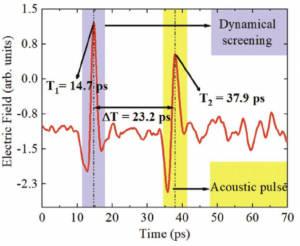
A Mannan; F Renee; G Bagsican; K Yamahara; I Kawayama; H Murakami; H Bremers; U Rossow; A Hangleiter; D Turchinovich; M Tonouchi
Ultrafast terahertz nanoseismology of GaInN/GaN multiple quantum wells Journal Article
In: Adv. Optical Mater., pp. 2100258, 2021.
@article{Mannan2021,
title = {Ultrafast terahertz nanoseismology of GaInN/GaN multiple quantum wells},
author = {A Mannan and F Renee and G Bagsican and K Yamahara and I Kawayama and H Murakami and H Bremers and U Rossow and A Hangleiter and D Turchinovich and M Tonouchi},
doi = {10.1002/adom.202100258},
year = {2021},
date = {2021-05-04},
journal = {Adv. Optical Mater.},
pages = {2100258},
abstract = {Terahertz (THz) emission spectroscopy and microscopy are applied to investigate the electron and lattice dynamics of Ga0.8In0.2N/GaN multiple quantum wells (MQWs). The THz emission consists of three distinct, differently timed signals, whose physical mechanisms are attributed to i) laser‐induced ultrafast dynamical screening of built‐in bias electric field in MQWs followed by ii) capacitive charge oscillation of the excited carriers and iii) the coherent acoustic phonon (CAP)‐driven polarization surge at the discontinuity between the GaN capping layer and air. These multifunctional optical responses show strong dependence on the quantum well width and photon energies. The temporal separation between the first and third THz pulses corresponds to the propagation of the CAP across the GaN capping layer of the MQW structure, whose thickness can thus be determined with 10 nm precision.},
keywords = {},
pubstate = {published},
tppubtype = {article}
}
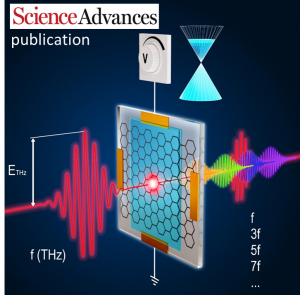
S Kovalev; H A Hafez; K -J Tielrooij; J -C Deinert; I Ilyakov; N Awari; Alcaraz D Iranzo; K Soundarapandian; D Saleta; S Germanskiy; M Chen; M Bawatna; B Green; F H L Koppens; M Mittendorff; M Bonn; M Gensch; D Turchinovich
Electrical tunability of terahertz nonlinearity in graphene Journal Article
In: Science Advances, vol. 7, pp. eabf9809, 2021.
@article{Kovalev2021bb,
title = {Electrical tunability of terahertz nonlinearity in graphene},
author = {S Kovalev and H A Hafez and K -J Tielrooij and J -C Deinert and I Ilyakov and N Awari and Alcaraz D Iranzo and K Soundarapandian and D Saleta and S Germanskiy and M Chen and M Bawatna and B Green and F H L Koppens and M Mittendorff and M Bonn and M Gensch and D Turchinovich},
doi = {10.1126/sciadv.abf9809},
year = {2021},
date = {2021-04-07},
journal = {Science Advances},
volume = {7},
pages = {eabf9809},
abstract = {Graphene is conceivably the most nonlinear optoelectronic material we know. Its nonlinear optical coefficients in the terahertz frequency range surpass those of other materials by many orders of magnitude. Here, we show that the terahertz nonlinearity of graphene, both for ultrashort single-cycle and quasi-monochromatic multicycle input terahertz signals, can be efficiently controlled using electrical gating, with gating voltages as low as a few volts. For example, optimal electrical gating enhances the power conversion efficiency in terahertz third-harmonic generation in graphene by about two orders of magnitude. Our experimental results are in quantitative agreement with a physical model of the graphene nonlinearity, describing the time-dependent thermodynamic balance maintained within the electronic population of graphene during interaction with ultrafast electric fields. Our results can serve as a basis for straightforward and accurate design of devices and applications for efficient electronic signal processing in graphene at ultrahigh frequencies.},
keywords = {},
pubstate = {published},
tppubtype = {article}
}
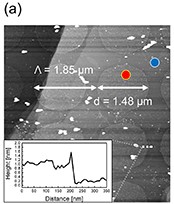
M Chin; S Matschy; Stawitzkiand F J Poojali; H A Hafez; D Turchinovich; S Winnerl; G Kumar; R Myers-Ward; M Dejarld; K Daniels; H D Drew; T Murphy; M Mittendorff
Observation of strong magneto plasmonic nonlinearity in bilayer graphene discs Journal Article
In: J. Phys. Photon., vol. 3, pp. 01LT01, 2021.
@article{Chin2021,
title = {Observation of strong magneto plasmonic nonlinearity in bilayer graphene discs},
author = {M Chin and S Matschy and Stawitzkiand F J Poojali and H A Hafez and D Turchinovich and S Winnerl and G Kumar and R Myers-Ward and M Dejarld and K Daniels and H D Drew and T Murphy and M Mittendorff},
url = {https://iopscience.iop.org/article/10.1088/2515-7647/abd7d0/pdf},
doi = {https://doi.org/10.1088/2515-7647/abd7d0},
year = {2021},
date = {2021-01-15},
journal = {J. Phys. Photon.},
volume = {3},
pages = {01LT01},
abstract = {Graphene patterned into plasmonic structures like ribbons or discs strongly increases the linear
and nonlinear optical interaction at resonance. The nonlinear optical response is governed by hot
carriers, leading to a red-shift of the plasmon frequency. In magnetic fields, the plasmon hybridizes
with the cyclotron resonance, resulting in a splitting of the plasmonic absorption into two
branches. Here we present how this splitting can be exploited to tune the nonlinear optical
response of graphene discs. In the absence of a magnetic field, a strong pump-induced increase in
on-resonant transmission can be observed, but fields in the range of 3 T can change the
characteristics completely, leading to an inverted nonlinearity. A two temperature model is
provided that describes the observed behavior well.},
keywords = {},
pubstate = {published},
tppubtype = {article}
}
and nonlinear optical interaction at resonance. The nonlinear optical response is governed by hot
carriers, leading to a red-shift of the plasmon frequency. In magnetic fields, the plasmon hybridizes
with the cyclotron resonance, resulting in a splitting of the plasmonic absorption into two
branches. Here we present how this splitting can be exploited to tune the nonlinear optical
response of graphene discs. In the absence of a magnetic field, a strong pump-induced increase in
on-resonant transmission can be observed, but fields in the range of 3 T can change the
characteristics completely, leading to an inverted nonlinearity. A two temperature model is
provided that describes the observed behavior well.
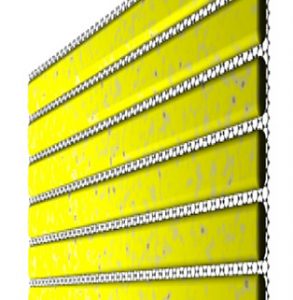
J -C Deinert; Alcaraz D Iranzo; R Pérez; X Jia; H A Hafez; I Ilyakov; N Awari; M Chen; M Bawatna; A N Ponomaryov; S Germanskiy; M Bonn; F H L Koppens; D Turchinovich; M Gensch; S Kovalev; K -J Tielrooij
Grating-Graphene Metamaterial as a Platform for Terahertz Nonlinear Photonics Journal Article
In: ACS Nano, vol. 15, pp. 1145, 2021.
@article{Deinert2021,
title = {Grating-Graphene Metamaterial as a Platform for Terahertz Nonlinear Photonics},
author = {J -C Deinert and Alcaraz D Iranzo and R Pérez and X Jia and H A Hafez and I Ilyakov and N Awari and M Chen and M Bawatna and A N Ponomaryov and S Germanskiy and M Bonn and F H L Koppens and D Turchinovich and M Gensch and S Kovalev and K -J Tielrooij},
url = {https://pubs.acs.org/doi/full/10.1021/acsnano.0c08106},
doi = {https://doi.org/10.1021/acsnano.0c08106},
year = {2021},
date = {2021-01-01},
journal = {ACS Nano},
volume = {15},
pages = {1145},
abstract = {Nonlinear optics is an increasingly important field for scientific and technological applications, owing to its relevance and potential for optical and optoelectronic technologies. Currently, there is an active search for suitable nonlinear material systems with efficient conversion and a small material footprint. Ideally, the material system should allow for chip integration and room-temperature operation. Two-dimensional materials are highly interesting in this regard. Particularly promising is graphene, which has demonstrated an exceptionally large nonlinearity in the terahertz regime. Yet, the light–matter interaction length in two-dimensional materials is inherently minimal, thus limiting the overall nonlinear optical conversion efficiency. Here, we overcome this challenge using a metamaterial platform that combines graphene with a photonic grating structure providing field enhancement. We measure terahertz third-harmonic generation in this metamaterial and obtain an effective third-order nonlinear susceptibility with a magnitude as large as 3 × 10–8 m2/V2, or 21 esu, for a fundamental frequency of 0.7 THz. This nonlinearity is 50 times larger than what we obtain for graphene without grating. Such an enhancement corresponds to a third-harmonic signal with an intensity that is 3 orders of magnitude larger due to the grating. Moreover, we demonstrate a field conversion efficiency for the third harmonic of up to ∼1% using a moderate field strength of ∼30 kV/cm. Finally, we show that harmonics beyond the third are enhanced even more strongly, allowing us to observe signatures of up to the ninth harmonic. Grating-graphene metamaterials thus constitute an outstanding platform for commercially viable, CMOS-compatible, room-temperature, chip-integrated, THz nonlinear conversion applications.},
keywords = {},
pubstate = {published},
tppubtype = {article}
}
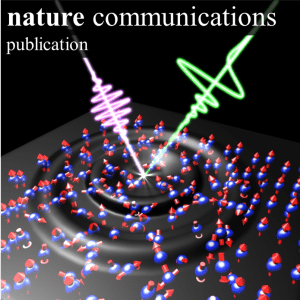
W Zhang; P Maldonado; Z Jin; T S Seifert; J Arabski; G Schmerber; E Beaurepaire; M Bonn; T Kampfrath; P M Oppeneer; D Turchinovich
Ultrafast terahertz magnetometry Journal Article
In: Nature Commun., vol. 11, pp. 4247, 2020.
@article{Zhang2020,
title = {Ultrafast terahertz magnetometry},
author = {W Zhang and P Maldonado and Z Jin and T S Seifert and J Arabski and G Schmerber and E Beaurepaire and M Bonn and T Kampfrath and P M Oppeneer and D Turchinovich},
doi = {https://doi.org/10.1038/s41467-020-17935-6},
year = {2020},
date = {2020-08-25},
journal = {Nature Commun.},
volume = {11},
pages = {4247},
abstract = {A material’s magnetic state and its dynamics are of great fundamental research interest and are also at the core of a wide plethora of modern technologies. However, reliable access to magnetization dynamics in materials and devices on the technologically relevant ultrafast timescale, and under realistic device-operation conditions, remains a challenge. Here, we demonstrate a method of ultrafast terahertz (THz) magnetometry, which gives direct access to the (sub-)picosecond magnetization dynamics even in encapsulated materials or devices in a contact-free fashion, in a fully calibrated manner, and under ambient conditions. As a showcase for this powerful method, we measure the ultrafast magnetization dynamics in a laser-excited encapsulated iron film. Our measurements reveal and disentangle distinct contributions originating from (i) incoherent hot-magnon-driven magnetization quenching and (ii) coherent acoustically-driven modulation of the exchange interaction in iron, paving the way to technologies utilizing ultrafast heat-free control of magnetism. High sensitivity and relative ease of experimental arrangement highlight the promise of ultrafast THz magnetometry for both fundamental studies and the technological applications of magnetism.},
keywords = {},
pubstate = {published},
tppubtype = {article}
}
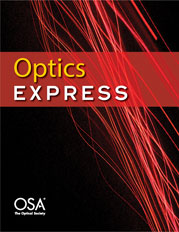
R K Jain; A J Hoffman; P U Jepsen; P Q Liu; D Turchinovich; M S Vitiello
Mid-infrared, long-wave infrared, and terahertz photonics: introduction Journal Article
In: Opt. Express, vol. 28, pp. 14169, 2020.
@article{Jain2020,
title = {Mid-infrared, long-wave infrared, and terahertz photonics: introduction},
author = {R K Jain and A J Hoffman and P U Jepsen and P Q Liu and D Turchinovich and M S Vitiello},
doi = {https://doi.org/10.1364/OE.395165},
year = {2020},
date = {2020-04-28},
journal = {Opt. Express},
volume = {28},
pages = {14169},
abstract = {This feature issue presents recent progress in long-wavelength photonics, focusing on wavelengths that span the mid-infrared (3–50 µm), the long-wavelength infrared (30–60 µm), and the terahertz (60–300 µm) portions of the electromagnetic spectrum. The papers in this feature issue report recent progress in the generation, manipulation, detection, and use of light across this long-wave region of the “photonics spectrum,” including novel sources and cutting edge advances in detectors, long-wavelength non-linear processes, optical metamaterials and metasurfaces, and molecular spectroscopy. The range of topics covered in this feature issue provide an excellent insight into the expanding interest in long-wavelength photonics, which could open new possibilities for basic research and applications in industries that span health, environmental, and security.
© 2020 Optical Society of America under the terms of the OSA Open Access Publishing Agreement},
keywords = {},
pubstate = {published},
tppubtype = {article}
}
© 2020 Optical Society of America under the terms of the OSA Open Access Publishing Agreement
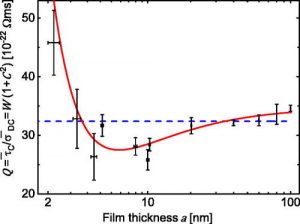
K L Krewer; W Zhang; J Arabski; G Schreiber; E Beaurepaire; M Bonn; D Turchinovich
Thickness-dependent electron momentum relaxation times in iron films Journal Article
In: Appl. Phys. Lett., vol. 116, pp. 102406, 2020.
@article{Krewer2020,
title = {Thickness-dependent electron momentum relaxation times in iron films},
author = {K L Krewer and W Zhang and J Arabski and G Schreiber and E Beaurepaire and M Bonn and D Turchinovich},
doi = {https://doi.org/10.1063/1.5142479},
year = {2020},
date = {2020-03-10},
journal = {Appl. Phys. Lett.},
volume = {116},
pages = {102406},
abstract = {Terahertz time-domain conductivity measurements in 2–100 nm thick iron films resolve the femtosecond time delay between the applied electric fields and the resulting currents. This current response time decreases from 29 fs for the thickest films to 7 fs for the thinnest films. The macroscopic response time is not strictly proportional to the conductivity. This excludes the existence of a single relaxation time universal for all conduction electrons. We must assume a distribution of microscopic momentum relaxation times. The macroscopic response time depends on the average and variation of this distribution; the observed deviation between the response time and conductivity scaling corresponds to the scaling of the variation. The variation of microscopic relaxation times depends on the film thickness because electrons with different relaxation times are affected differently by the confinement since they have different mean free paths.},
keywords = {},
pubstate = {published},
tppubtype = {article}
}
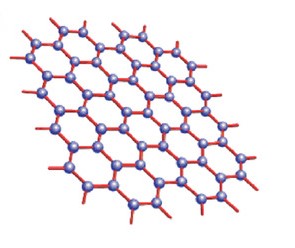
H A Hafez; S Kovalev; K -J Tielrooij; M Bonn; M Gensch; D Turchinovich
Terahertz Nonlinear Optics of Graphene: From Saturable Absorption to High-Harmonics Generation Journal Article
In: Adv. Optical Mater., vol. 8, pp. 1900771, 2020.
@article{Hafez2020,
title = {Terahertz Nonlinear Optics of Graphene: From Saturable Absorption to High-Harmonics Generation},
author = {H A Hafez and S Kovalev and K -J Tielrooij and M Bonn and M Gensch and D Turchinovich},
doi = {https://doi.org/10.1002/adom.201900771},
year = {2020},
date = {2020-02-05},
journal = {Adv. Optical Mater.},
volume = {8},
pages = {1900771},
abstract = {Graphene has long been predicted to show exceptional nonlinear optical properties, especially in the technologically important terahertz (THz) frequency range. Recent experiments have shown that this atomically thin material indeed exhibits possibly the largest nonlinear coefficients of any material known to date, paving the way for practical graphene‐based applications in ultrafast (opto‐)electronics operating at THz rates. Here the advances in the booming field of nonlinear THz optics of graphene are reported, and the state‐of‐the‐art understanding of the nature of the nonlinear interaction of graphene with the THz fields based on the thermodynamic model of electron transport in graphene is described. A comparison between different mechanisms of nonlinear interaction of graphene with light fields in THz, infrared, and visible frequency ranges is also provided. Finally, the perspectives for the expected technological applications of graphene based on its extraordinary THz nonlinear properties are summarized. This report covers the evolution of the field of THz nonlinear optics of graphene from the very pioneering to the state‐of‐the‐art works. It also serves as a concise overview of the current understanding of THz nonlinear optics of graphene and as a compact reference for researchers entering the field, as well as for the technology developers.},
keywords = {},
pubstate = {published},
tppubtype = {article}
}
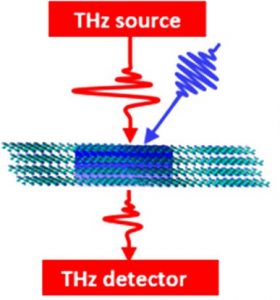
G Li; N Amer; H A Hafez; S Huang; D Turchinovich; V N Mochalin; F A Hegmann; L V Titova
Dynamical Control over Terahertz Electromagnetic Interference Shielding with 2D Ti3C2TyMXene by Ultrafast Optical Pulses Journal Article
In: Nano. Lett., vol. 20, pp. 636, 2019.
@article{Li2019,
title = {Dynamical Control over Terahertz Electromagnetic Interference Shielding with 2D Ti3C2TyMXene by Ultrafast Optical Pulses},
author = {G Li and N Amer and H A Hafez and S Huang and D Turchinovich and V N Mochalin and F A Hegmann and L V Titova},
doi = {https://doi.org/10.1021/acs.nanolett.9b04404},
year = {2019},
date = {2019-12-11},
journal = {Nano. Lett.},
volume = {20},
pages = {636},
abstract = {High electrical conductivity and strong absorption of electromagnetic radiation in the terahertz (THz) frequency range by metallic 2D MXene Ti3C2Ty make it a promising material for electromagnetic interference shielding, THz detectors, and transparent conducting electrodes. Here, we demonstrate that ultrafast optical pulses with wavelengths straddling the visible range (400 and 800 nm) induce transient broad-band THz transparency in the MXene that persists for nanoseconds. We demonstrate that optically induced transient THz transparency is independent of temperature from 95 to 290 K. This discovery opens new possibilities for development of switchable electromagnetic interference shielding materials and devices that can be rendered partially transparent on demand for transmitting THz signals, or for designing new THz devices such as sensitive optically gated detectors.},
keywords = {},
pubstate = {published},
tppubtype = {article}
}
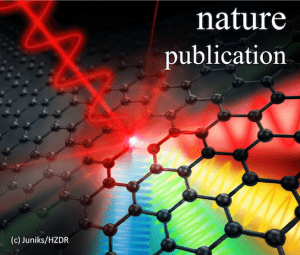
H A Hafez; S Kovalev; J -C Deinert; Z Mics; B Green; N Awari; M Chen; S Germanskiy; U Lehnert; J Teichert; Z Wang; K -J Tielrooij; Z Liu; Z Chen; A Narita; K Müllen; M Bonn; M Gensch; D.Turchinovich
Extremely efficient terahertz high-harmonic generation in graphene by hot Dirac fermions Journal Article
In: Nature, vol. 561, pp. 507, 2018.
@article{Hafez2018,
title = {Extremely efficient terahertz high-harmonic generation in graphene by hot Dirac fermions},
author = {H A Hafez and S Kovalev and J -C Deinert and Z Mics and B Green and N Awari and M Chen and S Germanskiy and U Lehnert and J Teichert and Z Wang and K -J Tielrooij and Z Liu and Z Chen and A Narita and K Müllen and M Bonn and M Gensch and D.Turchinovich},
doi = {https://doi.org/10.1038/s41586-018-0508-1},
year = {2018},
date = {2018-09-10},
journal = {Nature},
volume = {561},
pages = {507},
abstract = {Multiple optical harmonic generation—the multiplication of photon energy as a result of nonlinear interaction between light and matter—is a key technology in modern electronics and optoelectronics, because it allows the conversion of optical or electronic signals into signals with much higher frequency, and the generation of frequency combs. Owing to the unique electronic band structure of graphene, which features massless Dirac fermions1,2,3, it has been repeatedly predicted that optical harmonic generation in graphene should be particularly efficient at the technologically important terahertz frequencies4,5,6. However, these predictions have yet to be confirmed experimentally under technologically relevant operation conditions. Here we report the generation of terahertz harmonics up to the seventh order in single-layer graphene at room temperature and under ambient conditions, driven by terahertz fields of only tens of kilovolts per centimetre, and with field conversion efficiencies in excess of 10−3, 10−4 and 10−5 for the third, fifth and seventh terahertz harmonics, respectively. These conversion efficiencies are remarkably high, given that the electromagnetic interaction occurs in a single atomic layer. The key to such extremely efficient generation of terahertz high harmonics in graphene is the collective thermal response of its background Dirac electrons to the driving terahertz fields. The terahertz harmonics, generated via hot Dirac fermion dynamics, were observed directly in the time domain as electromagnetic field oscillations at these newly synthesized higher frequencies. The effective nonlinear optical coefficients of graphene for the third, fifth and seventh harmonics exceed the respective nonlinear coefficients of typical solids by 7–18 orders of magnitude7,8,9. Our results provide a direct pathway to highly efficient terahertz frequency synthesis using the present generation of graphene electronics, which operate at much lower fundamental frequencies of only a few hundreds of gigahertz.},
keywords = {},
pubstate = {published},
tppubtype = {article}
}
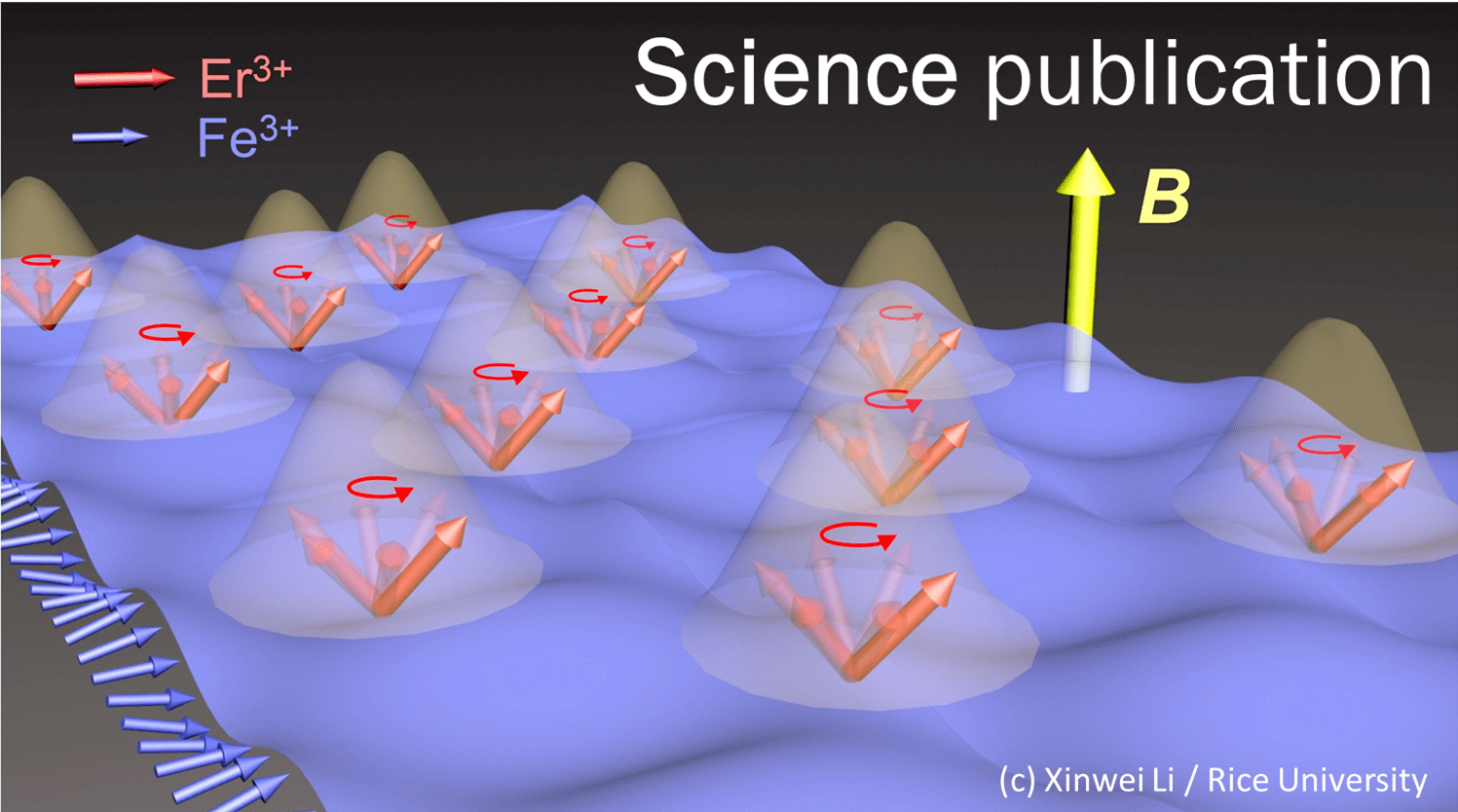
X Li; M Bamba; N Yuan; Q Zhang; Y Zhao; M Xiang; K Xu; Z Jin; W Ren; G Ma; S Cao; D Turchinovich; J Kono
Observation of Dicke cooperativity in magnetic interactions Journal Article
In: Science, vol. 361, pp. 794, 2018.
@article{Li2018,
title = {Observation of Dicke cooperativity in magnetic interactions},
author = {X Li and M Bamba and N Yuan and Q Zhang and Y Zhao and M Xiang and K Xu and Z Jin and W Ren and G Ma and S Cao and D Turchinovich and J Kono},
doi = {10.1126/science.aat5162},
year = {2018},
date = {2018-08-24},
journal = {Science},
volume = {361},
pages = {794},
abstract = {The interaction of N two-level atoms with a single-mode light field is an extensively studied many-body problem in quantum optics, first analyzed by Dicke in the context of superradiance. A characteristic of such systems is the cooperative enhancement of the coupling strength by a factor of N. In this study, we extended this cooperatively enhanced coupling to a solid-state system, demonstrating that it also occurs in a magnetic solid in the form of matter-matter interaction. Specifically, the exchange interaction of N paramagnetic erbium(III) (Er3+) spins with an iron(III) (Fe3+) magnon field in erbium orthoferrite (ErFeO3) exhibits a vacuum Rabi splitting whose magnitude is proportional to N. Our results provide a route for understanding, controlling, and predicting novel phases of condensed matter using concepts and tools available in quantum optics.},
keywords = {},
pubstate = {published},
tppubtype = {article}
}
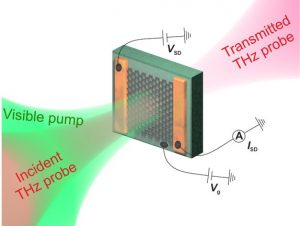
A Tomadin; S M Hornett; H.I.Wang; E.M.Alexeev; A Candini; C Coletti; D.Turchinovich; M Kläui; M Bonn; F H L Koppens; E Hendry; M Pollini; K -J Tielrooij
The ultrafast dynamics and conductivity of photoexcited graphene at different Fermi energies Journal Article
In: Science Advances, vol. 4, pp. eaar5313, 2018.
@article{Tomadin2018,
title = {The ultrafast dynamics and conductivity of photoexcited graphene at different Fermi energies},
author = {A Tomadin and S M Hornett and H.I.Wang and E.M.Alexeev and A Candini and C Coletti and D.Turchinovich and M Kläui and M Bonn and F H L Koppens and E Hendry and M Pollini and K -J Tielrooij},
doi = {10.1126/sciadv.aar5313},
year = {2018},
date = {2018-05-11},
journal = {Science Advances},
volume = {4},
pages = {eaar5313},
abstract = {For many of the envisioned optoelectronic applications of graphene, it is crucial to understand the subpicosecond carrier dynamics immediately following photoexcitation and the effect of photoexcitation on the electrical conductivity—the photoconductivity. Whereas these topics have been studied using various ultrafast experiments and theoretical approaches, controversial and incomplete explanations concerning the sign of the photoconductivity, the occurrence and significance of the creation of additional electron-hole pairs, and, in particular, how the relevant processes depend on Fermi energy have been put forward. We present a unified and intuitive physical picture of the ultrafast carrier dynamics and the photoconductivity, combining optical pump–terahertz probe measurements on a gate-tunable graphene device, with numerical calculations using the Boltzmann equation. We distinguish two types of ultrafast photo-induced carrier heating processes: At low (equilibrium) Fermi energy (EF ≲ 0.1 eV for our experiments), broadening of the carrier distribution involves interband transitions (interband heating). At higher Fermi energy (EF ≳ 0.15 eV), broadening of the carrier distribution involves intraband transitions (intraband heating). Under certain conditions, additional electron-hole pairs can be created [carrier multiplication (CM)] for low EF, and hot carriers (hot-CM) for higher EF. The resultant photoconductivity is positive (negative) for low (high) EF, which in our physical picture, is explained using solely electronic effects: It follows from the effect of the heated carrier distributions on the screening of impurities, consistent with the DC conductivity being mostly due to impurity scattering. The importance of these insights is highlighted by a discussion of the implications for graphene photodetector applications.},
keywords = {},
pubstate = {published},
tppubtype = {article}
}
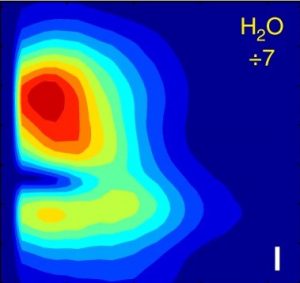
M Grechko; T Hasegawa; F D'Angelo; H Ito; D Turchinovich; Y Nagata; M Bonn
Coupling between intra- and intermolecular motions in liquid water revealed by two-dimensional terahertz-infrared-visible spectroscopy Journal Article
In: Nature Communications, vol. 9, pp. 885, 2018.
@article{Grechko2018,
title = {Coupling between intra- and intermolecular motions in liquid water revealed by two-dimensional terahertz-infrared-visible spectroscopy},
author = {M Grechko and T Hasegawa and F D'Angelo and H Ito and D Turchinovich and Y Nagata and M Bonn},
doi = {https://doi.org/10.1038/s41467-018-03303-y},
year = {2018},
date = {2018-02-28},
journal = {Nature Communications},
volume = {9},
pages = {885},
abstract = {The interaction between intramolecular and intermolecular degrees of freedom in liquid water underlies fundamental chemical and physical phenomena such as energy dissipation and proton transfer. Yet, it has been challenging to elucidate the coupling between these different types of modes. Here, we report on the direct observation and quantification of the coupling between intermolecular and intramolecular coordinates using two-dimensional, ultra-broadband, terahertz-infrared-visible (2D TIRV) spectroscopy and molecular dynamics calculations. Our study reveals strong coupling of the O-H stretch vibration, independent of the degree of delocalization of this high-frequency mode, to low-frequency intermolecular motions over a wide frequency range from 50 to 250 cm−1, corresponding to both the intermolecular hydrogen bond bending (≈ 60 cm−1) and stretching (≈ 180 cm−1) modes. Our results provide mechanistic insights into the coupling of the O-H stretch vibration to collective, delocalized intermolecular modes.},
keywords = {},
pubstate = {published},
tppubtype = {article}
}
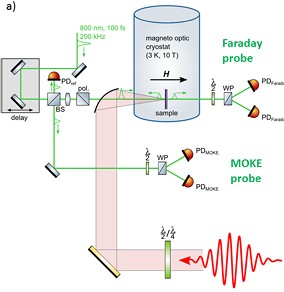
S Kovalev; Z Wang; J -C Deinert; N Awari; M Chen; B Green; S Germanskiy; T V A G de Oliveira; J S Lee; A Deac; D Turchinovich; N Stojanovic; S Eisebitt; I Radu; S Bonetti; T Kampfrath; M Gensch
Selective THz control of magnetic order: new opportunities from superradiant undulator sources Journal Article
In: J. Phys. D. Appl. Phys., vol. 51, pp. 114007, 2018.
@article{Kovalev2018,
title = {Selective THz control of magnetic order: new opportunities from superradiant undulator sources},
author = {S Kovalev and Z Wang and J -C Deinert and N Awari and M Chen and B Green and S Germanskiy and T V A G de Oliveira and J S Lee and A Deac and D Turchinovich and N Stojanovic and S Eisebitt and I Radu and S Bonetti and T Kampfrath and M Gensch},
doi = {https://doi.org/10.1088/1361-6463/aaac75},
year = {2018},
date = {2018-02-23},
journal = {J. Phys. D. Appl. Phys.},
volume = {51},
pages = {114007},
abstract = {Recent advancements of accelerator technology enable the generation of carrier-envelope-phase stable THz pulses with high fields at adjustable high repetition rates. The appropriate choice of THz radiator allows generation of narrow-band, spectrally dense, multicycle THz transients of tunable THz frequency which are ideally suited to selectively excite low-energy excitations such as magnons or phonons. They also allow one to study the frequency dependence of nonresonant THz-field interactions with various order parameters with high dynamic range. In this paper, we discuss the future prospects of this new type of THz light source for studying the coherent control of magnetic order based on recent results.},
keywords = {},
pubstate = {published},
tppubtype = {article}
}
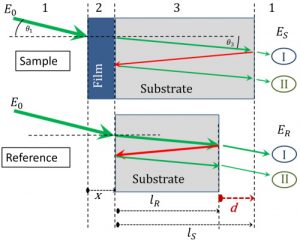
K Krewer; Z Mics; J Arabski; G Schmerber; E Beaurepaire; M Bonn; D Turchinovich
Accurate terahertz spectroscopy of supported thin films by precise substrate thickness correction Journal Article
In: Opt. Lett., vol. 43, pp. 447, 2018.
@article{Krewer2018,
title = {Accurate terahertz spectroscopy of supported thin films by precise substrate thickness correction},
author = {K Krewer and Z Mics and J Arabski and G Schmerber and E Beaurepaire and M Bonn and D Turchinovich},
doi = {10.1364/OL.43.000447},
year = {2018},
date = {2018-02-01},
journal = {Opt. Lett.},
volume = {43},
pages = {447},
abstract = {We present a new approach for accurate terahertz time-domain spectroscopy of thin films deposited on dielectric substrates. Our approach relies on the simultaneous measurement of film and substrate, allowing for 15 nm---precise determination of the thickness variation between the sample and reference. Our approach allows for unprecedentedly accurate determination of the terahertz conductivity of the thin film. We demonstrate our approach on a 10 nm thin iron film deposited on a 500 $mu$m MgO substrate. We determine the Drude momentum relaxation time in iron to within 0.15 fs uncertainty.},
keywords = {},
pubstate = {published},
tppubtype = {article}
}
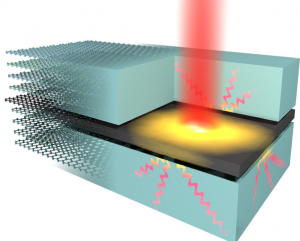
K -J Tielrooij; N C H Hesp; A Prinzipi; M B Lundeberg; E A A Pogna; L Banszerus; Z Mics; M Massicotte; P Schmidt; D Davydovskaya; D G Purdie; I Goykhman; G Soavi; A Lombardo; K Watanabe; T Taniguchi; M Bonn; D Turchinovich; C Stampfer; A C Ferrari; G Cerullo; M Pollini; F H L Koppens
Out-of-plane heat transfer in van der Waals stacks through electron-hyperbolic phonon coupling Journal Article
In: Nature Nanotechnology, vol. 13, pp. 41, 2018.
@article{Tielrooij2018,
title = {Out-of-plane heat transfer in van der Waals stacks through electron-hyperbolic phonon coupling},
author = {K -J Tielrooij and N C H Hesp and A Prinzipi and M B Lundeberg and E A A Pogna and L Banszerus and Z Mics and M Massicotte and P Schmidt and D Davydovskaya and D G Purdie and I Goykhman and G Soavi and A Lombardo and K Watanabe and T Taniguchi and M Bonn and D Turchinovich and C Stampfer and A C Ferrari and G Cerullo and M Pollini and F H L Koppens},
doi = {https://doi.org/10.1038/s41565-017-0008-8},
year = {2018},
date = {2018-01-01},
journal = {Nature Nanotechnology},
volume = {13},
pages = {41},
abstract = {Van der Waals heterostructures have emerged as promising building blocks that offer access to new physics, novel device functionalities and superior electrical and optoelectronic properties1,2,3,4,5,6,7. Applications such as thermal management, photodetection, light emission, data communication, high-speed electronics and light harvesting8,9,10,11,12,13,14,15,16 require a thorough understanding of (nanoscale) heat flow. Here, using time-resolved photocurrent measurements, we identify an efficient out-of-plane energy transfer channel, where charge carriers in graphene couple to hyperbolic phonon polaritons17,18,19 in the encapsulating layered material. This hyperbolic cooling is particularly efficient, giving picosecond cooling times for hexagonal BN, where the high-momentum hyperbolic phonon polaritons enable efficient near-field energy transfer. We study this heat transfer mechanism using distinct control knobs to vary carrier density and lattice temperature, and find excellent agreement with theory without any adjustable parameters. These insights may lead to the ability to control heat flow in van der Waals heterostructures.},
keywords = {},
pubstate = {published},
tppubtype = {article}
}
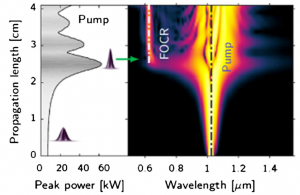
X Liu; J Lægsgaard; R Iegorov; A S Svane; F Ö Ilday; H Tu; S A Boppart; D Turchinovich
Nonlinearity-tailored fiber laser technology for low-noise, ultra-wideband tunable femtosecond light generation Journal Article
In: Photonics Research, vol. 6, pp. 750, 2017.
@article{Liu2017b,
title = {Nonlinearity-tailored fiber laser technology for low-noise, ultra-wideband tunable femtosecond light generation},
author = {X Liu and J Lægsgaard and R Iegorov and A S Svane and F Ö Ilday and H Tu and S A Boppart and D Turchinovich},
doi = {https://doi.org/10.1364/PRJ.5.000750},
year = {2017},
date = {2017-12-05},
journal = {Photonics Research},
volume = {6},
pages = {750},
abstract = {The emission wavelength of a laser is physically predetermined by the gain medium used. Consequently, arbitrary wavelength generation is a fundamental challenge in the science of light. Present solutions include optical parametric generation, requiring complex optical setups and spectrally sliced supercontinuum, taking advantage of a simpler fiber technology: a fixed-wavelength pump laser pulse is converted into a spectrally very broadband output, from which the required resulting wavelength is then optically filtered. Unfortunately, this process is associated with an inherently poor noise figure, which often precludes many realistic applications of such supercontinuum sources. Here, we show that by adding only one passive optical element—a tapered photonic crystal fiber—to a fixed-wavelength femtosecond laser, one can in a very simple manner resonantly convert the laser emission wavelength into an ultra-wide and continuous range of desired wavelengths, with very low inherent noise, and without mechanical realignment of the laser. This is achieved by exploiting the double interplay of nonlinearity and chirp in the laser source and chirp and phase matching in the tapered fiber. As a first demonstration of this simple and inexpensive technology, we present a femtosecond fiber laser continuously tunable across the entire red–green–blue spectral range.
© 2017 Chinese Laser Press},
keywords = {},
pubstate = {published},
tppubtype = {article}
}
© 2017 Chinese Laser Press
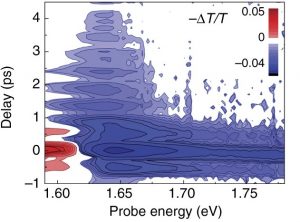
H Kim; J Hunger; E Cánovas; M Karakus; Z Mics; M Grechko; D Turchinovich; S H Parekh; M Bonn
Direct observation of mode-specific phonon-band gap coupling in methylammonium lead halide perovskites Journal Article
In: Nature Communications, vol. 8, pp. 687, 2017.
@article{Kim2017,
title = {Direct observation of mode-specific phonon-band gap coupling in methylammonium lead halide perovskites},
author = {H Kim and J Hunger and E Cánovas and M Karakus and Z Mics and M Grechko and D Turchinovich and S H Parekh and M Bonn},
doi = {https://doi.org/10.1038/s41467-017-00807-x},
year = {2017},
date = {2017-09-25},
journal = {Nature Communications},
volume = {8},
pages = {687},
abstract = {Methylammonium lead iodide perovskite is an outstanding semiconductor for photovoltaics. One of its intriguing peculiarities is that the band gap of this perovskite increases with increasing lattice temperature. Despite the presence of various thermally accessible phonon modes in this soft material, the understanding of how precisely these phonons affect macroscopic material properties and lead to the peculiar temperature dependence of the band gap has remained elusive. Here, we report a strong coupling of a single phonon mode at the frequency of ~ 1 THz to the optical band gap by monitoring the transient band edge absorption after ultrafast resonant THz phonon excitation. Excitation of the 1 THz phonon causes a blue shift of the band gap over the temperature range of 185 ~ 300 K. Our results uncover the mode-specific coupling between one phonon and the optical properties, which contributes to the temperature dependence of the gap in the tetragonal phase.},
keywords = {},
pubstate = {published},
tppubtype = {article}
}

K Krewer; K Jiang; K Bley; Z Mics; Z Jin; C K Weiss; K Landfester; H J Elmers; M Bonn; D Turchinovich
Large area conductive nanoaperture arrays with strong optical resonances and spectrally flat terahertz transmission Journal Article
In: Appl. Phys. Lett., vol. 111, pp. 021107, 2017.
@article{Krewer2017,
title = {Large area conductive nanoaperture arrays with strong optical resonances and spectrally flat terahertz transmission},
author = {K Krewer and K Jiang and K Bley and Z Mics and Z Jin and C K Weiss and K Landfester and H J Elmers and M Bonn and D Turchinovich},
doi = {https://doi.org/10.1063/1.4992131},
year = {2017},
date = {2017-07-11},
journal = {Appl. Phys. Lett.},
volume = {111},
pages = {021107},
abstract = {Using simple and inexpensive nanosphere lithography, we produce large, centimeter-squared sized thin golden films patterned with a hexagonal array of nanoapertures with controllable dimensions on the order of 100–300 nm, spaced by a 350–375 nm pitch distance. The optical transmission spectra of our samples are dominated by the resonant plasmonic features in the spectral range 500–700 nm, caused by the nanostructure in the film. At the same time, the transmission at terahertz (THz) radiation is as high as ∼10% and is spectrally flat. Our measurements are in agreement with finite difference time domain simulations. Such thin metal hole array films allow for very efficient injection of optical energy, while at the same time maintaining reasonably high transparency of THz waves. These structures can be used in any application combining strong optical sensitivity and THz transparency, in optical biomolecular sensing, or as optically transparent electrodes.
We acknowledge Helma Burg for technical assistance, Ivan Ivanov for helpful discussions, and EU Career Integration Grant (334324 LIGHTER), Graduate School of Excellence MAINZ, and Max Planck Society for financial support. We acknowledge the use of Fiji17 for image processing.},
keywords = {},
pubstate = {published},
tppubtype = {article}
}
We acknowledge Helma Burg for technical assistance, Ivan Ivanov for helpful discussions, and EU Career Integration Grant (334324 LIGHTER), Graduate School of Excellence MAINZ, and Max Planck Society for financial support. We acknowledge the use of Fiji17 for image processing.
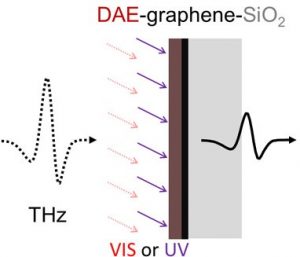
Z Liu; H I Wang; A Narita; Q Chen; Z Mics; D Turchinovich; M Kläui; M Bonn; K Müllen
Photoswitchable micro-supercapacitor based on a diarylethene-graphene composite film Journal Article
In: J. Am. Chem. Soc., vol. 139, pp. 9443, 2017.
@article{Liu2017bb,
title = {Photoswitchable micro-supercapacitor based on a diarylethene-graphene composite film},
author = {Z Liu and H I Wang and A Narita and Q Chen and Z Mics and D Turchinovich and M Kläui and M Bonn and K Müllen},
doi = {10.1021/jacs.7b04491},
year = {2017},
date = {2017-06-26},
journal = {J. Am. Chem. Soc.},
volume = {139},
pages = {9443},
abstract = {Stimuli-responsive micro-supercapacitors
(MSCs) controlled by external stimuli can enable a wide
range of applications for future on-chip energy storage.
Here, we report on a photoswitchable MSC based on a
diarylethene-graphene composite film. The microdevice
delivers an outstanding and reversible capacitance
modulation of up to 20%, demonstrating a prototype
photoswitchable MSC. Terahertz spectroscopy indicates
that the photoswitching of the capacitance is enabled by
the reversible tuning of interfacial charge injection into
diarylethene molecular orbitals, as a consequence of charge
transfer at the diarylethene−graphene interface upon light
modulation.},
keywords = {},
pubstate = {published},
tppubtype = {article}
}
(MSCs) controlled by external stimuli can enable a wide
range of applications for future on-chip energy storage.
Here, we report on a photoswitchable MSC based on a
diarylethene-graphene composite film. The microdevice
delivers an outstanding and reversible capacitance
modulation of up to 20%, demonstrating a prototype
photoswitchable MSC. Terahertz spectroscopy indicates
that the photoswitching of the capacitance is enabled by
the reversible tuning of interfacial charge injection into
diarylethene molecular orbitals, as a consequence of charge
transfer at the diarylethene−graphene interface upon light
modulation.
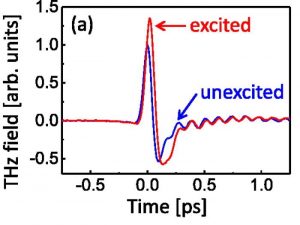
D Turchinovich; F D'Angelo; M Bonn
Femtosecond-timescale buildup of electron mobility in GaAs observed via ultrabroadband transient terahertz spectroscopy Journal Article
In: Appl. Phys. Lett., vol. 110, pp. 121102, 2017.
@article{Turchinovich2017,
title = {Femtosecond-timescale buildup of electron mobility in GaAs observed via ultrabroadband transient terahertz spectroscopy},
author = {D Turchinovich and F D'Angelo and M Bonn},
doi = {https://doi.org/10.1063/1.4978648},
year = {2017},
date = {2017-05-20},
journal = {Appl. Phys. Lett.},
volume = {110},
pages = {121102},
abstract = {The buildup of photoconductivity in an archetypal polar semiconductor GaAs was monitored on the timescale of carrier-carrier and carrier-lattice correlations, with sub-50 fs temporal resolution provided by ultra-broadband transient terahertz spectroscopy. Two relevant timescales are identified: the transition in photoconductivity from a regime of extremely weak screening to a screened Drude plasma was observed on the ∼280 fs timescale, followed by the gradual increase and saturation of electron mobility on a timescale of ∼160 fs. The Drude photoconductivity picture following carrier photoinjection was found to stabilize only on the timescale corresponding to several lattice and plasma oscillations.
We are grateful to H. Němec and P. Kužel for their assistance in the data analysis and to Z. Mics, I. Ivanov, and K. Krewer for helpful discussions. Financial support from European Union Marie Curie Program (EU Career Integration Grant No. 334324 “LIGHTER”) and Max Planck Society is gratefully acknowledged.},
keywords = {},
pubstate = {published},
tppubtype = {article}
}
We are grateful to H. Němec and P. Kužel for their assistance in the data analysis and to Z. Mics, I. Ivanov, and K. Krewer for helpful discussions. Financial support from European Union Marie Curie Program (EU Career Integration Grant No. 334324 “LIGHTER”) and Max Planck Society is gratefully acknowledged.
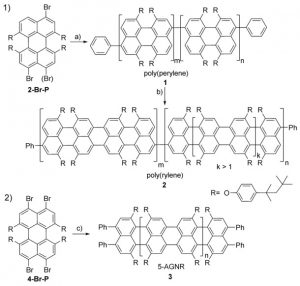
D Jänsch; I Ivanov; Y Zagranyarski; I Duznovic; M Baumgarten; D Turchinovich; M Bonn; K Müllen
Ultra-Narrow Low-Bandgap Graphene Nanoribbons from Bromoperylenes - Synthesis and Terahertz-Spectroscopy Journal Article
In: Chemistry - A European Journal, vol. 23, pp. 4870, 2017.
@article{Jänsch2017,
title = {Ultra-Narrow Low-Bandgap Graphene Nanoribbons from Bromoperylenes - Synthesis and Terahertz-Spectroscopy},
author = {D Jänsch and I Ivanov and Y Zagranyarski and I Duznovic and M Baumgarten and D Turchinovich and M Bonn and K Müllen},
doi = {https://doi.org/10.1002/chem.201605859},
year = {2017},
date = {2017-05-20},
journal = {Chemistry - A European Journal},
volume = {23},
pages = {4870},
abstract = {Soluble ultra‐narrow armchair graphene nanoribbons (AGNRs) with length of ≈20 nm and completely fused cores exceeding 5 nm in length, pronounced near‐infrared (NIR) absorption up to 1400 nm, and a low band gap (≈0.9 eV) are synthesized from 3,9(3,10)‐dibromoperylene and 3,4,9,10‐tetrabromoperylene. Since the monomers are obtained from perylene carboxyanhydrides, a remarkable link between dye and graphene chemistry is established. The two‐step protocol for the AGNR synthesis by aryl–aryl coupling and subsequent cyclodehydrogenation is compared with a direct Yamamoto polymerization. Ultrafast photoconductivity analysis by optical pump‐terahertz (THz) probe spectroscopy of the longest AGNRs excited in the NIR regime (800 nm) reveal their high intrinsic charge carrier mobility.},
keywords = {},
pubstate = {published},
tppubtype = {article}
}
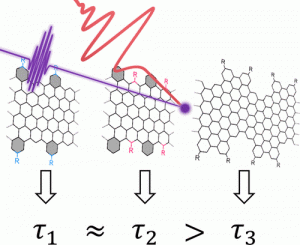
I Ivanov; Y Hu; S Osella; U Beser; H Wang; D Beljonne; A Narita; K Müllen; D Turchinovich; M Bonn
Role of edge engineering in photoconductiviy of graphene nano-ribbons Journal Article
In: J. Am. Chem. Soc., vol. 139, pp. 7982, 2017.
@article{Ivanov2017,
title = {Role of edge engineering in photoconductiviy of graphene nano-ribbons},
author = {I Ivanov and Y Hu and S Osella and U Beser and H Wang and D Beljonne and A Narita and K Müllen and D Turchinovich and M Bonn},
doi = {https://doi.org/10.1021/jacs.7b03467},
year = {2017},
date = {2017-05-19},
journal = {J. Am. Chem. Soc.},
volume = {139},
pages = {7982},
abstract = {The effect of edge engineering of graphene nanoribbons (GNRs) on their ultrafast photoconductivity is investigated. Three different GNRs were fabricated by bottom-up synthesis in the liquid phase, where structure, width, and edge planarity could be controlled chemically at the atomic level. The charge carrier transport in the fabricated GNRs was studied on the ultrafast, sub-picosecond time scale using time-resolved terahertz spectroscopy, giving access to the elementary parameters of carrier conduction. While the variation of the side chains does not alter the photoconductive properties of GNRs, the edge structure has a strong impact on the carrier mobility in GNRs by affecting the carrier momentum scattering rate. Calculations of the ribbon electronic structure and theoretical transport studies show that phonon scattering plays a significant role in microscopic conduction in GNRs with different edge structures. A comparison between theory and experiment indicates that the mean free path of charge carriers in the nanoribbons amounts to typically ∼20 nm.},
keywords = {},
pubstate = {published},
tppubtype = {article}
}
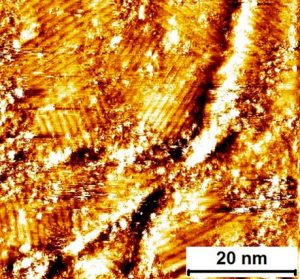
Z Chen; H I Wang; J Teyssandier; K S Mali; T Dumslaff; I Ivanov; W Zhang; P Ruffieux; R Fasel; H J Räder; D Turchinovich; De S Feyter; X Feng; M Kläui; A Narita; M Bonn; K Müllen
Chemical vapor deposition synthesis and terahertz photoconductivity of low-bandgap N = 9 armchair graphene nanoribbons Journal Article
In: J. Am. Chem. Soc., vol. 139, pp. 3635, 2017.
@article{Chen2017,
title = {Chemical vapor deposition synthesis and terahertz photoconductivity of low-bandgap N = 9 armchair graphene nanoribbons},
author = {Z Chen and H I Wang and J Teyssandier and K S Mali and T Dumslaff and I Ivanov and W Zhang and P Ruffieux and R Fasel and H J Räder and D Turchinovich and De S Feyter and X Feng and M Kläui and A Narita and M Bonn and K Müllen},
doi = {10.1021/jacs.7b00776},
year = {2017},
date = {2017-05-01},
journal = {J. Am. Chem. Soc.},
volume = {139},
pages = {3635},
abstract = {Recent advances in bottom-up synthesis of atomically defined graphene nanoribbons (GNRs) with various microstructures and properties have demonstrated their promise in electronic and optoelectronic devices. Here we synthesized N = 9 armchair graphene nanoribbons (9-AGNRs) with a low optical band gap of ∼1.0 eV and extended absorption into the infrared range by an efficient chemical vapor deposition process. Time-resolved terahertz spectroscopy was employed to characterize the photoconductivity in 9-AGNRs and revealed their high intrinsic charge-carrier mobility of approximately 350 cm2·V–1·s–1.},
keywords = {},
pubstate = {published},
tppubtype = {article}
}
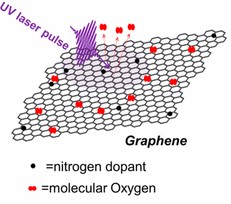
H I Wang; M -L Braatz; N Richter; K -J Tielrooij; Z Mics; H Lu; N -E Weber; K Müllen; D Turchinovich; M Kläui; M Bonn
Reversible photochemical control of doping levels in supported graphene Journal Article
In: J. Phys. Chem. C, vol. 121, pp. 4083, 2017.
@article{Wang2017,
title = {Reversible photochemical control of doping levels in supported graphene},
author = {H I Wang and M -L Braatz and N Richter and K -J Tielrooij and Z Mics and H Lu and N -E Weber and K Müllen and D Turchinovich and M Kläui and M Bonn},
doi = {10.1021/acs.jpcc.7b00347},
year = {2017},
date = {2017-01-20},
journal = {J. Phys. Chem. C},
volume = {121},
pages = {4083},
abstract = {Controlling the type and density of charge carriers in graphene is vital for a wide range of applications of this material in electronics and optoelectronics. To date, chemical doping and electrostatic gating have served as the two most established means to manipulate the carrier density in graphene. Although highly effective, these two approaches require sophisticated graphene growth or complex device fabrication processes to achieve both the desired nature and the doping densities with generally limited dynamic tunability and spatial control. Here, we report a convenient and tunable optical approach to tune the steady-state carrier density and Fermi energy in graphene by photochemically controlling the concentration of adsorbed molecular O2, a p-dopant in graphene, using femtosecond pulsed laser irradiation in the UV range. As an all-optical approach, it allows spatial control over doping levels. Combined terahertz (THz) spectroscopy and electrical device measurements reveal that the Fermi level in laser-illuminated graphene can be controllably and reversibly tuned between p- and n-type in a large range (over ∼600 meV from −420 to +180 meV) by readily tuning the peak intensity and the duration of the laser irradiation treatment. Furthermore, we demonstrate that our photochemical approach for doping of graphene allows one to optically write doping structure with spatial control. Given the ease, effectiveness, and simplicity of the method, this photochemical doping mechanism offers a simple, reversible approach to control the steady-state electronic and optical properties of graphene.},
keywords = {},
pubstate = {published},
tppubtype = {article}
}
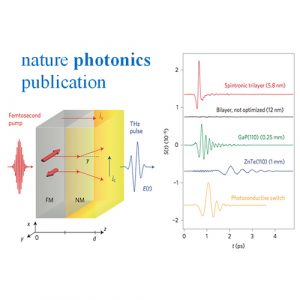
T Seifert; S Jaiswal; U Martens; J Hannegan; L Braun; P Maldonado; F Freimuth; A Kronenberg; J Henrizi; I Radu; F Freimuth; E Beaurepaire; Y Mokrousov; P M Oppeneer; M Jourdan; G Jakob; D Turchinovich; L M Hayden; M Wolf; M Münzenberg; M Kläui
Efficient metallic spintronic emitters of ultrabroadband terahertz radiation Journal Article
In: Nature Photonics, vol. 10, pp. 483, 2016.
@article{Seifert2016,
title = {Efficient metallic spintronic emitters of ultrabroadband terahertz radiation},
author = {T Seifert and S Jaiswal and U Martens and J Hannegan and L Braun and P Maldonado and F Freimuth and A Kronenberg and J Henrizi and I Radu and F Freimuth and E Beaurepaire and Y Mokrousov and P M Oppeneer and M Jourdan and G Jakob and D Turchinovich and L M Hayden and M Wolf and M Münzenberg and M Kläui},
doi = {https://doi.org/10.1038/nphoton.2016.91},
year = {2016},
date = {2016-05-23},
journal = {Nature Photonics},
volume = {10},
pages = {483},
abstract = {Terahertz electromagnetic radiation is extremely useful for numerous applications, including imaging and spectroscopy. It is thus highly desirable to have an efficient table-top emitter covering the 1–30 THz window that is driven by a low-cost, low-power femtosecond laser oscillator. So far, all solid-state emitters solely exploit physics related to the electron charge and deliver emission spectra with substantial gaps. Here, we take advantage of the electron spin to realize a conceptually new terahertz source that relies on three tailored fundamental spintronic and photonic phenomena in magnetic metal multilayers: ultrafast photoinduced spin currents, the inverse spin-Hall effect and a broadband Fabry–Pérot resonance. Guided by an analytical model, this spintronic route offers unique possibilities for systematic optimization. We find that a 5.8-nm-thick W/CoFeB/Pt trilayer generates ultrashort pulses fully covering the 1–30 THz range. Our novel source outperforms laser-oscillator-driven emitters such as ZnTe(110) crystals in terms of bandwidth, terahertz field amplitude, flexibility, scalability and cost.},
keywords = {},
pubstate = {published},
tppubtype = {article}
}
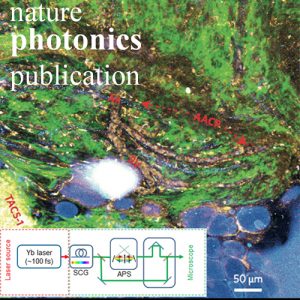
H Tu; Y Liu; D Turchinovich; M Marjanovic; J Lyngsø; J Lægsgaard; E J Chaney; Y Zhao; S You; W L Wilson; B Xu; M Dantus; S A Boppart
Stain-free histopathology by programmable supercontinuum pulses Journal Article
In: Nature Photonics, vol. 10, pp. 534, 2016.
@article{Tu2016,
title = {Stain-free histopathology by programmable supercontinuum pulses},
author = {H Tu and Y Liu and D Turchinovich and M Marjanovic and J Lyngsø and J Lægsgaard and E J Chaney and Y Zhao and S You and W L Wilson and B Xu and M Dantus and S A Boppart},
doi = {https://doi.org/10.1038/nphoton.2016.94},
year = {2016},
date = {2016-05-23},
journal = {Nature Photonics},
volume = {10},
pages = {534},
abstract = {The preparation, staining, visualization and interpretation of histological images of tissue is well accepted as the gold standard process for the diagnosis of disease. These methods have a long history of development, and are used ubiquitously in pathology, despite being highly time- and labour-intensive. Here, we introduce a unique optical imaging platform and methodology for label-free multimodal multiphoton microscopy that uses a novel photonic-crystal fibre source to generate tailored chemical contrast based on programmable supercontinuum pulses. We demonstrate the collection of optical signatures of the tumour microenvironment, including evidence of mesoscopic biological organization, tumour cell migration and (lymph-) angiogenesis collected directly from fresh ex vivo mammary tissue. Acquisition of these optical signatures and other cellular or extracellular features, which are largely absent from histologically processed and stained tissue, combined with an adaptable platform for optical alignment-free programmable-contrast imaging, offers the potential to translate stain-free molecular histopathology into routine clinical use.},
keywords = {},
pubstate = {published},
tppubtype = {article}
}
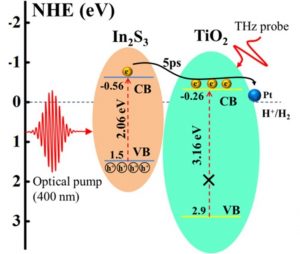
F Wang; Z Jin; Y Jiang; E H G Backus; M Bonn; S N Lou; D Turchinovich; R Amal
Probing the charge separation process on In2S3/Pt-TiO2 nanocomposites for boosted visible-light photocatalytic hydrogen production Journal Article
In: Appl. Catal. B: Environ., vol. 198, pp. 25, 2016.
@article{Wang2016,
title = {Probing the charge separation process on In2S3/Pt-TiO2 nanocomposites for boosted visible-light photocatalytic hydrogen production},
author = {F Wang and Z Jin and Y Jiang and E H G Backus and M Bonn and S N Lou and D Turchinovich and R Amal},
doi = {https://doi.org/10.1016/j.apcatb.2016.05.048},
year = {2016},
date = {2016-05-20},
journal = {Appl. Catal. B: Environ.},
volume = {198},
pages = {25},
abstract = {A simple refluxing wet-chemical approach is employed for fabricating In2S3/Pt-TiO2 heterogeneous catalysts for hydrogen generation under visible light irradiation. When the mass ratio between Pt-TiO2 and cubic-phased In2S3 (denoted as In2S3/Pt-TiO2) is two, the composite catalyst shows the highest hydrogen production, which exhibits an 82-fold enhancement over in-situ deposited Pt-In2S3. UV–vis diffuse reflectance and valence band X-ray photoelectron spectra elucidate that the conduction band of In2S3 is 0.3 eV more negative compared to that of TiO2, favouring charge separation in the nanocomposites. Photoelectrochemical transient photo-current measurements and optical pump – terahertz probe spectroscopic studies further corroborate the charge separation in In2S3/Pt-TiO2. The migration of photo-induced electrons from the In2S3 conduction band to the TiO2 conduction band and subsequently into the Pt nanoparticles is found to occur within 5 ps. Based on the experimental evidence, a charge separation process is proposed which accounts for the enhanced activity exhibited by the In2S3/Pt-TiO2 composite catalysts.},
keywords = {},
pubstate = {published},
tppubtype = {article}
}
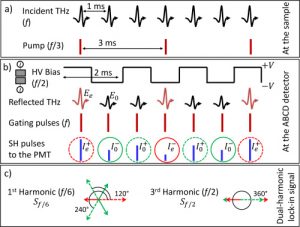
F D’Angelo; H Nemec; S H Parekh; P Kužel; M Bonn; D Turchinovich
Self-referenced ultra-broadband transient terahertz spectroscopy using air-photonics Journal Article
In: Optics Express, vol. 24, pp. 10157, 2016.
@article{D’Angelo2016,
title = {Self-referenced ultra-broadband transient terahertz spectroscopy using air-photonics},
author = {F D’Angelo and H Nemec and S H Parekh and P Kužel and M Bonn and D Turchinovich},
doi = {https://doi.org/10.1364/OE.24.010157},
year = {2016},
date = {2016-04-29},
journal = {Optics Express},
volume = {24},
pages = {10157},
abstract = {Terahertz (THz) air-photonics employs nonlinear interactions of ultrashort laser pulses in air to generate and detect THz pulses. As air is virtually non-dispersive, the optical-THz phase matching condition is automatically met, thus permitting the generation and detection of ultra-broadband THz pulses covering the entire THz spectral range without any gaps. Air-photonics naturally offers unique opportunities for ultra-broadband transient THz spectroscopy, yet many critical challenges inherent to this technique must first be resolved. Here, we present explicit guidelines for ultra-broadband transient THz spectroscopy with air-photonics, including a novel method for self-referenced signal acquisition minimizing the phase error, and the numerically-accurate approach to the transient reflectance data analysis.
© 2016 Optical Society of America},
keywords = {},
pubstate = {published},
tppubtype = {article}
}
© 2016 Optical Society of America
S Ilday; F Ö Ilday; R Hübner; T J Prosa; I Martin; G Nogay; I Kabacelik; Z Mics; M Bonn; D Turchinovich; H Toffoli; D Toffoli; D Friedrich; B Schmidt; K –H Heinig; R Turan
Multiscale self-assembly of silicon quantum dots into an anisotropic three-dimensional random network Journal Article
In: Nano. Lett., vol. 16, pp. 1942, 2016.
@article{Ilday2016,
title = {Multiscale self-assembly of silicon quantum dots into an anisotropic three-dimensional random network},
author = {S Ilday and F Ö Ilday and R Hübner and T J Prosa and I Martin and G Nogay and I Kabacelik and Z Mics and M Bonn and D Turchinovich and H Toffoli and D Toffoli and D Friedrich and B Schmidt and K –H Heinig and R Turan},
doi = {10.1021/acs.nanolett.5b05158},
year = {2016},
date = {2016-02-11},
journal = {Nano. Lett.},
volume = {16},
pages = {1942},
abstract = {Multiscale self-assembly is ubiquitous in nature but its deliberate use to synthesize multifunctional three-dimensional materials remains rare, partly due to the notoriously difficult problem of controlling topology from atomic to macroscopic scales to obtain intended material properties. Here, we propose a simple, modular, noncolloidal methodology that is based on exploiting universality in stochastic growth dynamics and driving the growth process under far-from-equilibrium conditions toward a preplanned structure. As proof of principle, we demonstrate a confined-but-connected solid structure, comprising an anisotropic random network of silicon quantum-dots that hierarchically self-assembles from the atomic to the microscopic scales. First, quantum-dots form to subsequently interconnect without inflating their diameters to form a random network, and this network then grows in a preferential direction to form undulated and branching nanowire-like structures. This specific topology simultaneously achieves two scale-dependent features, which were previously thought to be mutually exclusive: good electrical conduction on the microscale and a bandgap tunable over a range of energies on the nanoscale.},
keywords = {},
pubstate = {published},
tppubtype = {article}
}
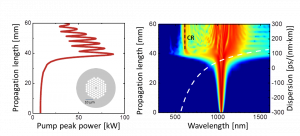
X Liu; A Svane; J Lægsgaard; H Tu; S A Boppart; D Turchinovich
Topical Review - Progress in Cherenkov femtosecond fiber lasers Journal Article
In: J. Phys. D: Appl. Phys., vol. 49, pp. 023001, 2016.
@article{Liu2016,
title = {Topical Review - Progress in Cherenkov femtosecond fiber lasers},
author = {X Liu and A Svane and J Lægsgaard and H Tu and S A Boppart and D Turchinovich},
doi = {https://doi.org/10.1088/0022-3727/49/2/023001},
year = {2016},
date = {2016-01-01},
journal = {J. Phys. D: Appl. Phys.},
volume = {49},
pages = {023001},
abstract = {We review the recent developments in the field of ultrafast Cherenkov fiber lasers. Two essential properties of such laser systems—broad wavelength tunability and high efficiency of Cherenkov radiation wavelength conversion are discussed. The exceptional performance of the Cherenkov fiber laser systems are highlighted—dependent on the realization scheme, the Cherenkov lasers can generate the femtosecond output tunable across the entire visible and even the UV range, and for certain designs more than 40% conversion efficiency from the pump to Cherenkov signal can be achieved. The femtosecond Cherenkov laser with all-fiber architecture is presented and discussed. Operating in the visible range, it delivers 100–200 fs wavelength-tunable pulses with multimilliwatt output power and exceptionally low noise figure an order of magnitude lower than the traditional wavelength tunable supercontinuum-based femtosecond sources. The applications for Cherenkov laser systems in practical biophotonics and biomedical applications, such as bio-imaging and microscopy, are discussed.},
keywords = {},
pubstate = {published},
tppubtype = {article}
}
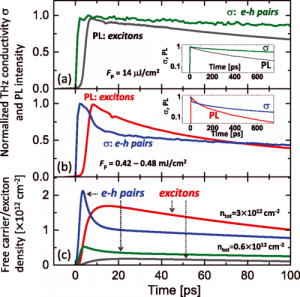
A Hangleiter; Z Jin; M Gerhard; D Kalincev; T Langer; H Bremers; U Rossow; M Koch; M Bonn; D Turchinovich
Efficient formation of excitons in a dense electron-hole plasma at room temperature Journal Article
In: Phys. Rev. B, vol. 92, pp. 241305, 2015.
@article{Hangleiter2015,
title = {Efficient formation of excitons in a dense electron-hole plasma at room temperature},
author = {A Hangleiter and Z Jin and M Gerhard and D Kalincev and T Langer and H Bremers and U Rossow and M Koch and M Bonn and D Turchinovich},
doi = {https://doi.org/10.1103/PhysRevB.92.241305},
year = {2015},
date = {2015-12-28},
journal = {Phys. Rev. B},
volume = {92},
pages = {241305},
abstract = {Commonly, excitons in semiconductors are regarded as a low-temperature, low carrier density phenomenon, becoming unstable as the temperature and carrier density increase. Contrary to the common expectation, our ultrafast conductivity and luminescence measurements in GaInN/GaN quantum wells reveal a highly efficient formation of radiative excitons from a high-density electron-hole plasma at room temperature, and provide a quantitative measure of the exciton fraction to reach more than 40% at a total carrier population as high as
∼10^13 cm^−2 Driven by the mass action of electrons and holes, this effect is believed to contribute to the extraordinarily high quantum efficiency of group-III nitride light emitters.},
keywords = {},
pubstate = {published},
tppubtype = {article}
}
∼10^13 cm^−2 Driven by the mass action of electrons and holes, this effect is believed to contribute to the extraordinarily high quantum efficiency of group-III nitride light emitters.
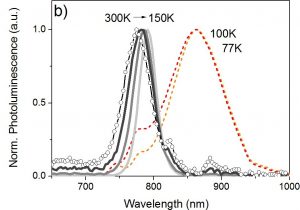
M Karakus; S A Jensen; F D'Angelo; D Turchinovich; M Bonn; E Canovas
Phonon-electron scattering limits free charge mobility in methylammonium lead iodide perovskites Journal Article
In: J. Phys. Chem. Lett., vol. 6, pp. 4991, 2015.
@article{Karakus2015,
title = {Phonon-electron scattering limits free charge mobility in methylammonium lead iodide perovskites},
author = {M Karakus and S A Jensen and F D'Angelo and D Turchinovich and M Bonn and E Canovas},
doi = {https://doi.org/10.1021/acs.jpclett.5b02485},
year = {2015},
date = {2015-11-30},
journal = {J. Phys. Chem. Lett.},
volume = {6},
pages = {4991},
abstract = {The nature of the photoconductivity in solution-processed films of methylammonium lead iodide perovskite is investigated by determining the variation of the photoconductive response with temperature. Ultrabroadband terahertz (THz) photoconductivity spectra in the 0.3–10 THz range can be reproduced well by a simple Drude-like response at room temperature, where free charge carrier motion is characterized by an average scattering time. The scattering time determined from Drude fits in the 0.3–2THz region increases from ∼4 fs at 300 K (tetragonal phase; mobility of ∼27 cm2 V–1 s–1) to almost ∼25 fs at 77 K (orthorhombic phase, mobility of ∼150 cm2 V–1 s–1). For the tetragonal phase (temperature range 150 < T < 300 K) the scattering time shows a ∼T–3/2 dependence, approaching the theoretical limit for pure acoustic phonon (deformation potential) scattering. Hence, electron–phonon, rather than impurity scattering, sets the upper limit on free charge transport for this perovskite.},
keywords = {},
pubstate = {published},
tppubtype = {article}
}
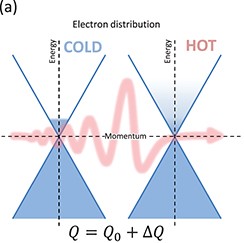
I Ivanov; M Bonn; Z Mics; D Turchinovich
Perspective on terahertz spectroscopy of graphene Journal Article
In: EPL, vol. 111, pp. 67001, 2015.
@article{Ivanov2015,
title = {Perspective on terahertz spectroscopy of graphene},
author = {I Ivanov and M Bonn and Z Mics and D Turchinovich},
doi = {10.1209/0295-5075/111/67001},
year = {2015},
date = {2015-11-01},
journal = {EPL},
volume = {111},
pages = {67001},
abstract = {Graphene has been an intensely studied material, owing to its unique band structure and concomitant outstanding electronic properties. In the past decades, ultrafast terahertz (THz) spectroscopy has developed into a powerful tool to characterize ultrafast charge carrier dynamics in a wide range of materials and material structures. In this Perspective we review recent experimental work exploring the ultrafast electron dynamics in graphene in the THz spectral range, and present a simple thermodynamic picture describing the THz linear, nonlinear, and photo-induced conductivity of this remarkable material.},
keywords = {},
pubstate = {published},
tppubtype = {article}
}
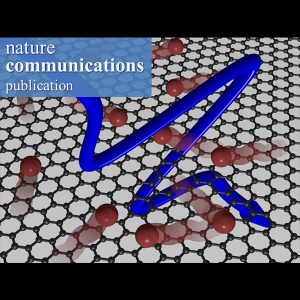
Z Mics; K -J Tielrooij; K Parvez; S A Jensen; I Ivanov; X Feng; K Müllen; M Bonn; D Turchinovich
Thermodynamic picture of ultrafast charge transport in graphene Journal Article
In: Nature Comm., vol. 6, pp. 7655, 2015.
@article{Mics2015,
title = {Thermodynamic picture of ultrafast charge transport in graphene},
author = {Z Mics and K -J Tielrooij and K Parvez and S A Jensen and I Ivanov and X Feng and K Müllen and M Bonn and D Turchinovich},
doi = {https://doi.org/10.1038/ncomms8655},
year = {2015},
date = {2015-07-16},
journal = {Nature Comm.},
volume = {6},
pages = {7655},
abstract = {The outstanding charge transport properties of graphene enable numerous electronic applications of this remarkable material, many of which are expected to operate at ultrahigh speeds. In the regime of ultrafast, sub-picosecond electric fields, however, the very high conduction properties of graphene are not necessarily preserved, with the physical picture explaining this behaviour remaining unclear. Here we show that in graphene, the charge transport on an ultrafast timescale is determined by a simple thermodynamic balance maintained within the graphene electronic system acting as a thermalized electron gas. The energy of ultrafast electric fields applied to graphene is converted into the thermal energy of its entire charge carrier population, near-instantaneously raising the electronic temperature. The dynamic interplay between heating and cooling of the electron gas ultimately defines the ultrafast conductivity of graphene, which in a highly nonlinear manner depends on the dynamics and the strength of the applied electric fields.},
keywords = {},
pubstate = {published},
tppubtype = {article}
}
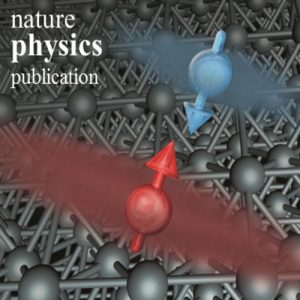
Z Jin; A Tkach; F Casper; V Spetter; H Grimm; A Thomas; T Kampfrath; M Bonn; M Kläui; D Turchinovich
Accessing the fundamentals of magnetotransport in metals with terahertz probes Journal Article
In: Nature Physics, vol. 11, pp. 761, 2015.
@article{Jin2015,
title = {Accessing the fundamentals of magnetotransport in metals with terahertz probes},
author = {Z Jin and A Tkach and F Casper and V Spetter and H Grimm and A Thomas and T Kampfrath and M Bonn and M Kläui and D Turchinovich},
doi = {https://doi.org/10.1038/nphys3384},
year = {2015},
date = {2015-07-06},
journal = {Nature Physics},
volume = {11},
pages = {761},
abstract = {Spin-dependent conduction in metals underlies all modern magnetic memory technologies, such as giant magnetoresistance (GMR). The charge current in ferromagnetic transition metals is carried by two non-mixing populations of sp-band Fermi-level electrons: one of majority-spin and one of minority-spin. These electrons experience spin-dependent momentum scattering with localized electrons, which originate from the spin-split d-band. The direct observation of magnetotransport under such fundamental conditions, however, requires magnetotransport measurements on the same timescale as the electron momentum scattering, which takes place in the sub-100 fs regime. Using terahertz electromagnetic probes, we directly observe the magnetotransport in a metallic system under the fundamental conditions, and determine the spin-dependent densities and momentum scattering times of conduction electrons. We show that traditional measurements significantly underestimate the spin asymmetry in electron scattering, a key parameter responsible for effects such as GMR. Furthermore, we demonstrate the possibility of magnetic modulation of terahertz waves, along with heat- and contact-free GMR readout using ultrafast terahertz signals.},
keywords = {},
pubstate = {published},
tppubtype = {article}
}
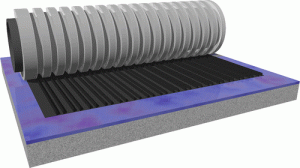
T Hallam; A Shakouri; E Poliani; A Rooney; I Ivanov; A Potie; H Taylor; M Bonn; D Turchinovich; S Haigh; J Maultzsch; G Duesberg
Controlled folding of graphene: GraFold printing Journal Article
In: Nano Lett., vol. 15, pp. 857, 2015.
@article{Hallam2014,
title = {Controlled folding of graphene: GraFold printing},
author = {T Hallam and A Shakouri and E Poliani and A Rooney and I Ivanov and A Potie and H Taylor and M Bonn and D Turchinovich and S Haigh and J Maultzsch and G Duesberg},
doi = {https://doi.org/10.1021/nl503460p},
year = {2015},
date = {2015-01-01},
journal = {Nano Lett.},
volume = {15},
pages = {857},
abstract = {We have used elastomeric stamps with periodically varying adhesive properties to introduce structure and print folded graphene films. The structure of the induced folds is investigated with scanning probe techniques, high-resolution electron-microscopy, and tip-enhanced Raman spectroscopy. Furthermore, a finite element model is developed to show the fold formation process. Terahertz spectroscopy reveals induced anisotropy of carrier mobility along, and perpendicular to, the graphene folds. Graphene fold printing is a new technique which allows for significant modification of the properties of 2D materials without damaging or chemically modifying them.},
keywords = {},
pubstate = {published},
tppubtype = {article}
}
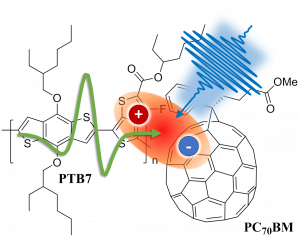
Z Jin; D Gehrig; C Dyer-Smith; E J Heilweil; F Laquai; M Bonn; D Turchinovich
Ultrafast THz photoconductivity of photovoltaic polymer-fullerene blends: a comparative study correlated with photovoltaic device performance Journal Article
In: J. Phys. Chem. Lett., vol. 5, pp. 3662, 2014.
@article{Jin2014,
title = {Ultrafast THz photoconductivity of photovoltaic polymer-fullerene blends: a comparative study correlated with photovoltaic device performance},
author = {Z Jin and D Gehrig and C Dyer-Smith and E J Heilweil and F Laquai and M Bonn and D Turchinovich},
doi = {https://doi.org/10.1021/jz501890n},
year = {2014},
date = {2014-10-10},
journal = {J. Phys. Chem. Lett.},
volume = {5},
pages = {3662},
abstract = {Ultrafast photoinduced carrier dynamics in prototypical low band gap polymer:fullerene photovoltaic blend films PTB7:PC70BM and P3HT:PC70BM is investigated using ultrafast terahertz (THz) spectroscopy. The subpicosecond and few-picosecond decays of THz-probed photoconductivities for both compounds are observed, attributed to the rapid formation of polaron pairs by exciton–exciton annihilation and subsequent polaron pair annihilation, respectively. The transient THz photoconductivity spectra of PTB7:PC70BM are well described by the Drude–Smith (DS) model, directly yielding the important charge transport parameters such as charge carrier density, momentum scattering time, and effective localization. By comparison with P3HT:PC70BM, we find that in PTB7:PC70BM the mobile charge carrier photoconductivity is significantly enhanced by a factor of 1.8 and prevails for longer times after charge formation, due to both improved mobile charge carrier yield and lower charge localization. In PTB7:PC70BM, a strong dependency of electron momentum scattering time on electron density was found, well parametrized by the empirical Caughey–Thomas model. The difference in ultrafast photoconductivities of both P3HT:PC70BM and PTB7:PC70BM is found to correlate very well with the performance of photovoltaic devices based on those materials.},
keywords = {},
pubstate = {published},
tppubtype = {article}
}
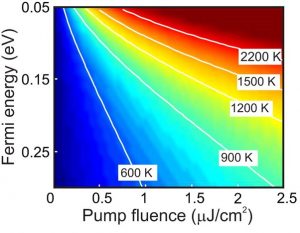
S A Jensen; Z Mics; I Ivanov; H S Varol; D Turchinovich; F H L Koppens; M Bonn; K J Tielrooij
Competing ultrafast energy relaxation pathways in photoexcited graphene Journal Article
In: Nano Lett., vol. 14, pp. 5839, 2014.
@article{Jensen2014,
title = {Competing ultrafast energy relaxation pathways in photoexcited graphene},
author = {S A Jensen and Z Mics and I Ivanov and H S Varol and D Turchinovich and F H L Koppens and M Bonn and K J Tielrooij},
doi = {https://doi.org/10.1021/nl502740g},
year = {2014},
date = {2014-09-23},
journal = {Nano Lett.},
volume = {14},
pages = {5839},
abstract = {For most optoelectronic applications of graphene, a thorough understanding of the processes that govern energy relaxation of photoexcited carriers is essential. The ultrafast energy relaxation in graphene occurs through two competing pathways: carrier–carrier scattering, creating an elevated carrier temperature, and optical phonon emission. At present, it is not clear what determines the dominating relaxation pathway. Here we reach a unifying picture of the ultrafast energy relaxation by investigating the terahertz photoconductivity, while varying the Fermi energy, photon energy and fluence over a wide range. We find that sufficiently low fluence (≲4 μJ/cm2) in conjunction with sufficiently high Fermi energy (≳0.1 eV) gives rise to energy relaxation that is dominated by carrier–carrier scattering, which leads to efficient carrier heating. Upon increasing the fluence or decreasing the Fermi energy, the carrier heating efficiency decreases, presumably due to energy relaxation that becomes increasingly dominated by phonon emission. Carrier heating through carrier–carrier scattering accounts for the negative photoconductivity for doped graphene observed at terahertz frequencies. We present a simple model that reproduces the data for a wide range of Fermi levels and excitation energies and allows us to qualitatively assess how the branching ratio between the two distinct relaxation pathways depends on excitation fluence and Fermi energy.},
keywords = {},
pubstate = {published},
tppubtype = {article}
}
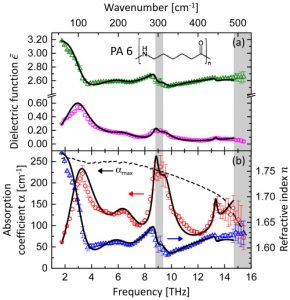
F D'Angelo; Z Mics; M Bonn; D Turchinovich
Ultra-broadband THz time-domain spectroscopy of common polymers using THz air photonics Journal Article
In: Opt. Express, vol. 22, pp. 12475, 2014.
@article{D'Angelo2014,
title = {Ultra-broadband THz time-domain spectroscopy of common polymers using THz air photonics},
author = {F D'Angelo and Z Mics and M Bonn and D Turchinovich},
doi = {https://doi.org/10.1364/OE.22.012475},
year = {2014},
date = {2014-05-15},
journal = {Opt. Express},
volume = {22},
pages = {12475},
abstract = {Terahertz-range dielectric properties of the common polymers low-density polyethylene (LDPE), cyclic olefin/ethylene copolymer (TOPAS®), polyamide-6 (PA6), and polytetrafluoroethylene (PTFE or Teflon®) are characterized in the ultra-broadband frequency window 2-15 THz, using a THz time-domain spectrometer employing air-photonics for the generation and detection of single-cycle sub-50 fs THz transients. The time domain measurements provide direct access to both the absorption and refractive index spectra. The polymers LDPE and TOPAS® demonstrate negligible absorption and spectrally-flat refractive index across the entire spectroscopy window, revealing the high potential of these polymers for applications in THz photonics such as ultra-broadband polymer-based dielectric mirrors, waveguides, and fibers. Resonant high-frequency polar vibrational modes are observed and assigned in polymers PA6 and PTFE, and their dielectric functions in the complete frequency window 2-15 THz are theoretically reproduced. Our results demonstrate the potential of ultra-broadband air-photonics-based THz time domain spectroscopy as a valuable analytic tool for materials science.
© 2014 Optical Society of America},
keywords = {},
pubstate = {published},
tppubtype = {article}
}
© 2014 Optical Society of America
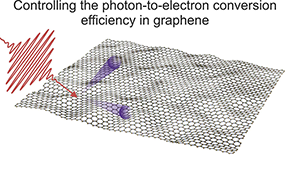
S A Jensen; R Ulbricht; A Narita; X Feng; K Müllen; T Hertel; D Turchinovich; M Bonn
Ultrafast photoconductivity of graphene nanoribbons and carbon nanotubes Journal Article
In: Nano Lett., vol. 13, pp. 5925, 2013.
@article{Jensen2013,
title = {Ultrafast photoconductivity of graphene nanoribbons and carbon nanotubes},
author = {S A Jensen and R Ulbricht and A Narita and X Feng and K Müllen and T Hertel and D Turchinovich and M Bonn},
doi = {https://doi.org/10.1021/nl402978s},
year = {2013},
date = {2013-10-04},
journal = {Nano Lett.},
volume = {13},
pages = {5925},
abstract = {We present a comparative study of the ultrafast photoconductivity in two different forms of one-dimensional (1D) quantum-confined graphene nanostructures: structurally well-defined semiconducting graphene nanoribbons (GNRs) fabricated by a “bottom-up” chemical synthesis approach and semiconducting carbon nanotubes (CNTs) with a similar bandgap energy. Transient photoconductivities of both materials were measured using time-resolved terahertz spectroscopy, allowing for contact-free measurements of complex-valued photoconductivity spectra with subpicosecond time-resolution. We show that, while the THz photoresponse seems very different for the two systems, a single model of free carriers experiencing backscattering when moving along the long axis of the CNTs or GNRs provides a quantitative description of both sets of results, revealing significantly longer carrier scattering times for CNTs (ca. 150 fs) than for GNRs (ca. 30 fs) and in turn higher carrier mobilities. This difference can be explained by differences in band structures and phonon scattering and the greater structural rigidity of CNTs as compared to GNRs, minimizing the influence of bending and/or torsional defects on the electron transport.},
keywords = {},
pubstate = {published},
tppubtype = {article}
}
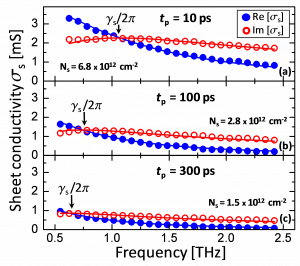
Z Mics; A D'Angio; S A Jensen; M Bonn; D Turchinovich
Density-dependent electron scattering in photoexcited GaAs in strongly diffusive regime Journal Article
In: Appl. Phys. Lett., vol. 102, pp. 231120, 2013.
@article{Mics2013,
title = {Density-dependent electron scattering in photoexcited GaAs in strongly diffusive regime},
author = {Z Mics and A D'Angio and S A Jensen and M Bonn and D Turchinovich},
doi = {https://doi.org/10.1063/1.4810756},
year = {2013},
date = {2013-06-12},
journal = {Appl. Phys. Lett.},
volume = {102},
pages = {231120},
abstract = {In a series of systematic optical pump–terahertz probe experiments, we study the density-dependent electron scattering rate in photoexcited GaAs in the regime of strong carrier diffusion. The terahertz frequency-resolved transient sheet conductivity spectra are perfectly described by the Drude model, directly yielding the electron scattering rates. A diffusion model is applied to determine the spatial extent of the photoexcited electron-hole gas at each moment after photoexcitation, yielding the time-dependent electron density, and hence the density-dependent electron scattering time. We find that the electron scattering time decreases from 320 to 60 fs, as the electron density changes from 1015 to 1019 cm−3.
We acknowledge financial support from the International Max Planck Research School, Max Planck Society, EU Marie Curie Program (Career Integration Grant 334324 “LIGHTER”), Danish Council for Independent Research (FTP project ALFIE), and Danish Proof-of-Concept Foundation (Grant 7.7 “Ultrahigh-speed wireless data communications”).
REFERENCES},
keywords = {},
pubstate = {published},
tppubtype = {article}
}
We acknowledge financial support from the International Max Planck Research School, Max Planck Society, EU Marie Curie Program (Career Integration Grant 334324 “LIGHTER”), Danish Council for Independent Research (FTP project ALFIE), and Danish Proof-of-Concept Foundation (Grant 7.7 “Ultrahigh-speed wireless data communications”).
REFERENCES
H P Porte; D Turchinovich; S Persheyev; Y Fan; M J Rose; P U Jepsen
On ultrafast photoconductivity dynamics and crystallinity of black silicon Journal Article
In: IEEE Trans. Terahertz Sci, Technol., vol. 3, pp. 331, 2013.
@article{Porte2013,
title = {On ultrafast photoconductivity dynamics and crystallinity of black silicon},
author = {H P Porte and D Turchinovich and S Persheyev and Y Fan and M J Rose and P U Jepsen},
doi = {10.1109/TTHZ.2013.2255917},
year = {2013},
date = {2013-04-23},
journal = {IEEE Trans. Terahertz Sci, Technol.},
volume = {3},
pages = {331},
abstract = {We investigate the carrier dynamics of thin films of black silicon, amorphous hydrogenated silicon which under laser annealing forms a microstructured surface with extremely high broadband optical absorption. We use Raman spectroscopy to determine the degree of crystallinity of the annealed surfaces, and investigate the dependence on crystallinity and fabrication method of the photoconductivity. Time-resolved THz spectroscopy is used to determine the evolution of the carrier scattering time and confinement of carriers on the picosecond time scale. We conclude that a fabrication method with high energy leading edge of the annealing laser results in black silicon with the largest photon-to-electron conversion efficiency, largest mobility, and longest carrier lifetime.},
keywords = {},
pubstate = {published},
tppubtype = {article}
}
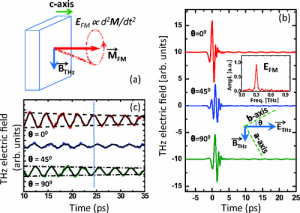
Z Jin; Z Mics; G Ma; Z Cheng; M Bonn; D Turchinovich
Single-pulse terahertz coherent control of spin resonance in the canted antiferromagnet YFeO3, mediated by dielectric anisotropy Journal Article
In: Phys. Rev. B, vol. 87, pp. 094422, 2013.
@article{Jin2013,
title = {Single-pulse terahertz coherent control of spin resonance in the canted antiferromagnet YFeO3, mediated by dielectric anisotropy},
author = {Z Jin and Z Mics and G Ma and Z Cheng and M Bonn and D Turchinovich},
doi = {https://doi.org/10.1103/PhysRevB.87.094422},
year = {2013},
date = {2013-03-25},
journal = {Phys. Rev. B},
volume = {87},
pages = {094422},
abstract = {We report on the coherent control of terahertz (THz) spin waves in a canted antiferromagnet yttrium orthoferrite, YFeO3
, associated with a quasiferromagnetic (quasi-FM) spin resonance at a frequency of 0.3 THz, using a single-incident THz pulse. The spin resonance is excited impulsively by the magnetic field component of the THz pulse. The intrinsic dielectric anisotropy of YFeO3
in the THz range allows for coherent control of both the amplitude and the phase of the excited spin wave. The coherent control is based on simultaneous generation of two interfering phase-shifted spin waves whose amplitudes and relative phase, dictated by the dielectric anisotropy of the YFeO3
crystal, can be controlled by varying the polarization of the incident THz pulse with respect to the crystal axes. The spatially anisotropic decay of the THz-excited FM spin resonance in YFeO3
, leading to an increasingly linear polarization of the THz oscillation at the spin resonance frequency, suggests a key role of magnon–phonon coupling in spin-wave energy dissipation.},
keywords = {},
pubstate = {published},
tppubtype = {article}
}
, associated with a quasiferromagnetic (quasi-FM) spin resonance at a frequency of 0.3 THz, using a single-incident THz pulse. The spin resonance is excited impulsively by the magnetic field component of the THz pulse. The intrinsic dielectric anisotropy of YFeO3
in the THz range allows for coherent control of both the amplitude and the phase of the excited spin wave. The coherent control is based on simultaneous generation of two interfering phase-shifted spin waves whose amplitudes and relative phase, dictated by the dielectric anisotropy of the YFeO3
crystal, can be controlled by varying the polarization of the incident THz pulse with respect to the crystal axes. The spatially anisotropic decay of the THz-excited FM spin resonance in YFeO3
, leading to an increasingly linear polarization of the THz oscillation at the spin resonance frequency, suggests a key role of magnon–phonon coupling in spin-wave energy dissipation.
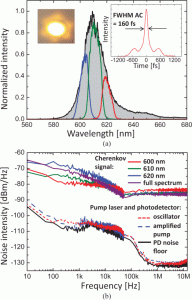
X Liu; G A Villanueva; J Lægsgaard; U Møller; H Tu; S A Boppart; D Turchinovich
Low-noise operation of all-fiber femtosecond Cherenkov laser Journal Article
In: IEEE Photon. Technol. Lett., vol. 25, pp. 892, 2013.
@article{Liu2013,
title = {Low-noise operation of all-fiber femtosecond Cherenkov laser},
author = {X Liu and G A Villanueva and J Lægsgaard and U Møller and H Tu and S A Boppart and D Turchinovich},
doi = {10.1109/LPT.2013.2253765},
year = {2013},
date = {2013-03-21},
journal = {IEEE Photon. Technol. Lett.},
volume = {25},
pages = {892},
abstract = {We investigate the noise properties of a femtosecond all-fiber Cherenkov radiation source with emission wavelength 600 nm, based on an Yb-fiber laser and a highly nonlinear photonic crystal fiber. A relative intensity noise as low as 103 dBc/Hz, corresponding to 2.48% pulse-to-pulse fluctuation in energy, is observed at the Cherenkov radiation output power of 4.3 mW, or 150 pJ-pulse energy. This pulse-to-pulse fluctuation is at least 10.6-dB lower compared to spectrally sliced supercontinuum sources traditionally used for ultrafast fiber-based generation at visible wavelengths. Low noise makes all-fiber Cherenkov sources promising for biophotonics applications such as multiphoton microscopy, where minimum pulse-to-pulse energy fluctuation is required. We present the dependency of the noise figure on both the Cherenkov radiation output power and its spectrum.},
keywords = {},
pubstate = {published},
tppubtype = {article}
}
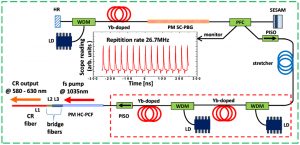
X Liu; J Lægsgaard; U Møller; H Tu; S A Boppart; D Turchinovich
All-fiber femtosecond Cherenkov radiation source Journal Article
In: Opt. Lett., vol. 37, pp. 2769, 2012.
@article{Liu2012b,
title = {All-fiber femtosecond Cherenkov radiation source},
author = {X Liu and J Lægsgaard and U Møller and H Tu and S A Boppart and D Turchinovich},
doi = {https://doi.org/10.1364/OL.37.002769},
year = {2012},
date = {2012-06-29},
journal = {Opt. Lett.},
volume = {37},
pages = {2769},
abstract = {An all-fiber femtosecond source of spectrally isolated Cherenkov radiation is reported, to the best of our knowledge, for the first time. Using a monolithic, self-starting femtosecond Yb-doped fiber laser as the pump source and the combination of photonic crystal fibers as the wave-conversion medium, we demonstrate milliwatt-level, stable, and tunable Cherenkov radiation at visible wavelengths 580–630 nm, with pulse duration of sub-160-fs, and the 3 dB spectral bandwidth not exceeding 36 nm. Such an all-fiber Cherenkov radiation source is promising for practical applications in biophotonics such as bioimaging and microscopy.
©2012 Optical Society of America},
keywords = {},
pubstate = {published},
tppubtype = {article}
}
©2012 Optical Society of America
D Turchinovich; J M Hvam; M C Hoffmann
Self-phase modulation of a single-cycle terahertz pulse by nonlinear free-carrier response in a semiconductor Journal Article
In: Phys. Ref. B, vol. 85, pp. 201304, 2012.
@article{Turchinovich2012,
title = {Self-phase modulation of a single-cycle terahertz pulse by nonlinear free-carrier response in a semiconductor},
author = {D Turchinovich and J M Hvam and M C Hoffmann},
doi = {https://doi.org/10.1103/PhysRevB.85.201304},
year = {2012},
date = {2012-05-29},
journal = {Phys. Ref. B},
volume = {85},
pages = {201304},
abstract = {We investigate the self-phase modulation (SPM) of a single-cycle terahertz pulse in a semiconductor, using bulk
n-GaAs as a model system. The SPM arises from the heating of free electrons in the electric field of the terahertz pulse, leading to an ultrafast reduction of the plasma frequency, and hence to a strong modification of the terahertz-range dielectric function of the material. Terahertz SPM is observed directly in the time domain. In the frequency domain it corresponds to a strong frequency-dependent refractive index nonlinearity of
n-GaAs, found to be both positive and negative within the broad spectrum of the terahertz pulse, with the zero-nonlinearity point defined by the electron momentum relaxation rate. We also observed the nonlinear spectral broadening and compression of the terahertz pulse.},
keywords = {},
pubstate = {published},
tppubtype = {article}
}
n-GaAs as a model system. The SPM arises from the heating of free electrons in the electric field of the terahertz pulse, leading to an ultrafast reduction of the plasma frequency, and hence to a strong modification of the terahertz-range dielectric function of the material. Terahertz SPM is observed directly in the time domain. In the frequency domain it corresponds to a strong frequency-dependent refractive index nonlinearity of
n-GaAs, found to be both positive and negative within the broad spectrum of the terahertz pulse, with the zero-nonlinearity point defined by the electron momentum relaxation rate. We also observed the nonlinear spectral broadening and compression of the terahertz pulse.
![Monolithic highly-stable Yb-doped femtosecond fiber lasers for applications in practical biophotonics [invited]](https://www.turchinovich-lab.de/wp-content/uploads/2021/04/Monolithic-Highly-Stable-Yb-Doped-Femtosecond-Fiber-Lasers-for-Applications-in-Practical-Biophotonics1.jpg)
X Liu; J Lægsgaard; D Turchinovich
Monolithic highly-stable Yb-doped femtosecond fiber lasers for applications in practical biophotonics [invited] Journal Article
In: IEEE J. Sel. Top. Quant. Electron., vol. 18, pp. 1439, 2012.
@article{Liu2012bb,
title = {Monolithic highly-stable Yb-doped femtosecond fiber lasers for applications in practical biophotonics [invited]},
author = {X Liu and J Lægsgaard and D Turchinovich},
doi = {10.1109/JSTQE.2012.2183580},
year = {2012},
date = {2012-01-09},
journal = {IEEE J. Sel. Top. Quant. Electron.},
volume = {18},
pages = {1439},
abstract = {Operational and environmental stability of ultrafast laser systems is critical for their applications in practical biophotonics. Mode-locked fiber lasers show great promise in applications such as supercontinuum sources or multiphoton microscopy systems. Recently, substantial progress has been made in the development of all-fiber nonlinear-optical laser control schemes, which resulted in the demonstration of highly stable monolithic, i.e., not containing any free-space elements, lasers with direct fiber-end delivery of femtosecond pulses. This paper provides an overview of the progress in the development of such all-fiber mode-locked lasers based on Yb-fiber as gain medium, operating at the wavelength around 1 μm, and delivering femtosecond pulses reaching tens of nanojoules of energy.},
keywords = {},
pubstate = {published},
tppubtype = {article}
}
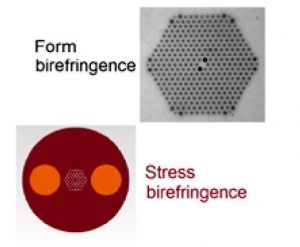
H Tu; Y Liu; X Liu; D Turchinovich; J Lægsgaard; S A Boppart
In: Opt. Express, vol. 20, pp. 1113, 2012.
@article{Tu2012,
title = {Nonlinear polarization dynamics in a weakly birefringent all-normal dispersion photonic crystal fiber: toward a practical coherent fiber supercontinuum laser},
author = {H Tu and Y Liu and X Liu and D Turchinovich and J Lægsgaard and S A Boppart},
doi = {https://doi.org/10.1364/OE.20.001113},
year = {2012},
date = {2012-01-04},
journal = {Opt. Express},
volume = {20},
pages = {1113},
abstract = {Dispersion-flattened dispersion-decreased all-normal dispersion (DFDD-ANDi) photonic crystal fibers have been identified as promising candidates for high-spectral-power coherent supercontinuum (SC) generation. However, the effects of the unintentional birefringence of the fibers on the SC generation have been ignored. This birefringence is widely present in nonlinear non-polarization maintaining fibers with a typical core size of 2 µm, presumably due to the structural symmetry breaks introduced in the fiber drawing process. We find that an intrinsic form-birefringence on the order of 10−5 profoundly affects the SC generation in a DFDD-ANDi photonic crystal fiber. Conventional simulations based on the scalar generalized nonlinear Schrödinger equation (GNLSE) fail to reproduce the prominent observed features of the SC generation in a short piece (9-cm) of this fiber. However, these features can be qualitatively or semi-quantitatively understood by the coupled GNLSE that takes into account the form-birefringence. The nonlinear polarization effects induced by the birefringence significantly distort the otherwise simple spectrotemporal field of the SC pulses. We therefore propose the fabrication of polarization-maintaining DFDD-ANDi fibers to avoid these adverse effects in pursuing a practical coherent fiber SC laser.
©2012 Optical Society of America},
keywords = {},
pubstate = {published},
tppubtype = {article}
}
©2012 Optical Society of America
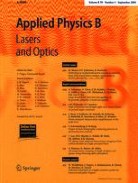
H Tu; Y Liu; J Lægsgaard; D Turchinovich; M Siegel; D Kopf; H Li; T Gunaratne; S A Boppart
In: Appl. Phys. B, vol. 106, pp. 379, 2012.
@article{Tu2011b,
title = {Cross-validation of theoretically quantified fiber continuum generation and absolute pulse measurement by MIIPS for a broadband coherently controlled optical source},
author = {H Tu and Y Liu and J Lægsgaard and D Turchinovich and M Siegel and D Kopf and H Li and T Gunaratne and S A Boppart},
doi = {https://doi.org/10.1007/s00340-011-4746-2},
year = {2012},
date = {2012-01-01},
journal = {Appl. Phys. B},
volume = {106},
pages = {379},
abstract = {The predicted spectral phase of a fiber continuum pulsed source rigorously quantified by the scalar generalized nonlinear Schrödinger equation is found to be in excellent agreement with that measured by multiphoton intrapulse interference phase scan (MIIPS) with background subtraction. This cross-validation confirms the absolute pulse measurement by MIIPS and the transform-limited compression of the fiber continuum pulses by the pulse shaper performing the MIIPS measurement, and permits the subsequent coherent control on the fiber continuum pulses by this pulse shaper. The combination of the fiber continuum source with the MIIPS-integrated pulse shaper produces compressed transform-limited 9.6 fs (FWHM) pulses or arbitrarily shaped pulses at a central wavelength of 1020 nm, an average power over 100 mW, and a repetition rate of 76 MHz. In comparison to the 229-fs pump laser pulses that generate the fiber continuum, the compressed pulses reflect a compression ratio of 24.},
keywords = {},
pubstate = {published},
tppubtype = {article}
}
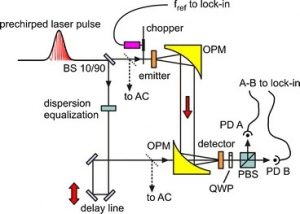
D N Erschens; D Turchinovich; P U Jepsen
Optimized optical rectification and electro-optic sampling in ZnTe crystals with chirped femtosecond laser pulse Journal Article
In: J. Infrared, Millimeter & THz Waves, vol. 32, pp. 1371, 2011.
@article{Erschens2011,
title = {Optimized optical rectification and electro-optic sampling in ZnTe crystals with chirped femtosecond laser pulse},
author = {D N Erschens and D Turchinovich and P U Jepsen},
doi = {https://doi.org/10.1007/s10762-011-9829-y},
year = {2011},
date = {2011-09-22},
journal = {J. Infrared, Millimeter & THz Waves},
volume = {32},
pages = {1371},
abstract = {We report on optimization of the intensity of THz signals generated and detected by optical rectification and electro-optic sampling in dispersive, nonlinear media. Addition of a negative prechirp to the femtosecond laser pulses used in the THz generation and detection processes in 1-mm thick ZnTe crystals leads to an increase of the THz intensity of more than 30% at low laser intensity and up to 60% at higher laser intensity. Dispersion compensation in the ZnTe crystal, which becomes significant for laser pulses with durations much less than 100 fs, is responsible for the enhanced generation and detection efficiency at low excitation intensity, and our simulations indicate that two-photon absorption is responsible for the increased efficiency enhancement observed at high excitation intensity.},
keywords = {},
pubstate = {published},
tppubtype = {article}
}
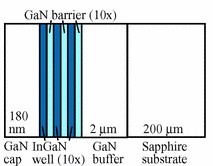
P J S van Capel; D Turchinovich; H P Porte; S Lahmann; U Rossow; A Hangleiter; J I Dijkhuis
Correlated terahertz acoustic and electromagnetic emission in dynamically screened InGaN/GaN quantum wells Journal Article
In: Phys. Rev. B, vol. 84, pp. 085317, 2011.
@article{vanCapel2011,
title = {Correlated terahertz acoustic and electromagnetic emission in dynamically screened InGaN/GaN quantum wells},
author = {P J S van Capel and D Turchinovich and H P Porte and S Lahmann and U Rossow and A Hangleiter and J I Dijkhuis},
doi = {https://doi.org/10.1103/PhysRevB.84.085317},
year = {2011},
date = {2011-08-26},
journal = {Phys. Rev. B},
volume = {84},
pages = {085317},
abstract = {We investigate acoustic and electromagnetic emission from optically excited strained piezoelectric In_0.2Ga_0.8
N/GaN multiple quantum wells (MQWs), using optical pump-probe spectroscopy, time-resolved Brillouin scattering, and THz emission spectroscopy. A direct comparison of detected acoustic signals and THz electromagnetic radiation signals demonstrates that transient strain generation in InGaN/GaN MQWs is correlated with electromagnetic THz generation, and both types of emission find their origin in ultrafast dynamical screening of the built-in piezoelectric field in the MQWs. The measured spectral intensity of the detected Brillouin signal corresponds to a maximum strain amplitude of generated acoustic pulses of 2%. This value coincides with the static lattice-mismatch-induced strain in In_0.2Ga_0.8
N/GaN, demonstrating the total release of static strain in MQWs via impulsive THz acoustic emission. This confirms the ultrafast dynamical screening mechanism in MQWs as a highly efficient method for impulsive strain generation.},
keywords = {},
pubstate = {published},
tppubtype = {article}
}
N/GaN multiple quantum wells (MQWs), using optical pump-probe spectroscopy, time-resolved Brillouin scattering, and THz emission spectroscopy. A direct comparison of detected acoustic signals and THz electromagnetic radiation signals demonstrates that transient strain generation in InGaN/GaN MQWs is correlated with electromagnetic THz generation, and both types of emission find their origin in ultrafast dynamical screening of the built-in piezoelectric field in the MQWs. The measured spectral intensity of the detected Brillouin signal corresponds to a maximum strain amplitude of generated acoustic pulses of 2%. This value coincides with the static lattice-mismatch-induced strain in In_0.2Ga_0.8
N/GaN, demonstrating the total release of static strain in MQWs via impulsive THz acoustic emission. This confirms the ultrafast dynamical screening mechanism in MQWs as a highly efficient method for impulsive strain generation.
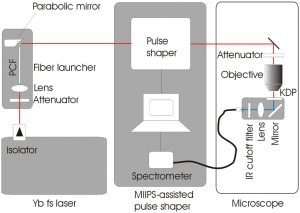
H Tu; Y Liu; D Turchinovich; S A Boppart
Compression of fiber supercontinuum pulses to the Fourier-limit in a high-numerical-aperture focus Journal Article
In: Opt. Lett., vol. 36, pp. 2315, 2011.
@article{Tu2011bb,
title = {Compression of fiber supercontinuum pulses to the Fourier-limit in a high-numerical-aperture focus},
author = {H Tu and Y Liu and D Turchinovich and S A Boppart},
doi = {https://doi.org/10.1364/OL.36.002315},
year = {2011},
date = {2011-06-14},
journal = {Opt. Lett.},
volume = {36},
pages = {2315},
abstract = {A multiphoton intrapulse interference phase scan (MIIPS) adaptively and automatically compensates the combined phase distortion from a fiber supercontinuum source, a spatial light modulator pulse shaper, and a high-NA microscope objective, allowing Fourier-transform-limited compression of the supercontinuum pulses at the focus of the objective. A second-harmonic-generation-based method is employed to independently validate the transform-limited compression. The compressed pulses at the focus of the objective have a tunable duration of 10.8–38.9 fs (FWHM), a central wavelength of ∼1020 nm, an average power of 18–70 mW, and a repetition rate of 76 MHz, permitting the application of this source to nonlinear optical microscopy and coherently controlled microspectroscopy.
© 2011 Optical Society of America},
keywords = {},
pubstate = {published},
tppubtype = {article}
}
© 2011 Optical Society of America
H P Porte; D B Turchinovich; S Persheyev; Y Fan; M J Rose; P U Jepsen
Effect of copper on the carrier lifetime in black Silicon Journal Article
In: J. Infrared, Millimeter & THz Waves, vol. 32, pp. 883, 2011.
@article{Porte2011,
title = {Effect of copper on the carrier lifetime in black Silicon},
author = {H P Porte and D B Turchinovich and S Persheyev and Y Fan and M J Rose and P U Jepsen},
doi = {https://doi.org/10.1007/s10762-011-9801-x},
year = {2011},
date = {2011-06-04},
journal = {J. Infrared, Millimeter & THz Waves},
volume = {32},
pages = {883},
abstract = {Black silicon is produced by laser annealing of a-Si:H films. During annealing, silicon microstructures are formed on the surface. We use time-resolved terahertz spectroscopy to study the photoconductivity dynamics in black silicon. We find that when a copper film is deposited on top of the a-Si:H layer prior to laser annealing, the carrier lifetime of black silicon is significantly reduced.},
keywords = {},
pubstate = {published},
tppubtype = {article}
}
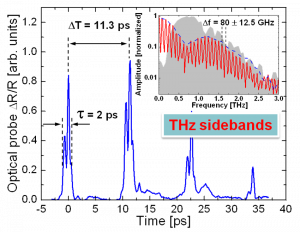
M C Hoffmann; B S Monozon; D A Livshits; E U Rafailov; D Turchinovich
Terahertz electro-absorption effect enabling femtosecond all-optical switching in semiconductor quantum dots Journal Article
In: Appl. Phys. Lett., vol. 97, pp. 231108, 2010.
@article{Hoffmann2010b,
title = {Terahertz electro-absorption effect enabling femtosecond all-optical switching in semiconductor quantum dots},
author = {M C Hoffmann and B S Monozon and D A Livshits and E U Rafailov and D Turchinovich},
doi = {https://doi.org/10.1063/1.3515909},
year = {2010},
date = {2010-12-08},
journal = {Appl. Phys. Lett.},
volume = {97},
pages = {231108},
abstract = {We demonstrate an instantaneous all-optical manipulation of optical absorption in InGaAs/GaAs quantum dots (QDs) via an electro-absorption effect induced by the electric field of an incident free-space terahertz signal. A terahertz signal with the full bandwidth of 3 THz was directly encoded onto an optical signal probing the absorption in QDs, resulting in the encoded temporal features as fast as 460 fs. The instantaneous nature of this effect enables femtosecond all-optical switching at very high repetition rates, suggesting applications in terahertz-range wireless communication systems with data rates of at least 0.5 Tbit/s.
We are grateful to Max Planck Society and EU FP7 Programme (FAST-DOT, Grant No. 224338) for partial financial support, and to A. Cavalleri (University of Hamburg), A.-P. Jauho (DTU Nanotech), and K. Yvind and J. M. Hvam (DTU Fotonik) for valuable discussions.},
keywords = {},
pubstate = {published},
tppubtype = {article}
}
We are grateful to Max Planck Society and EU FP7 Programme (FAST-DOT, Grant No. 224338) for partial financial support, and to A. Cavalleri (University of Hamburg), A.-P. Jauho (DTU Nanotech), and K. Yvind and J. M. Hvam (DTU Fotonik) for valuable discussions.
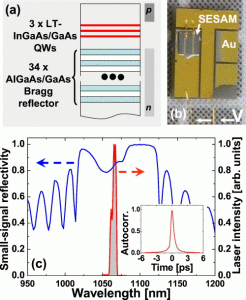
X Liu; E U Rafailov; D A Livshits; D Turchinovich
Quantum well saturable absorber mirror with electrical control of modulation depth Journal Article
In: Appl. Phys. Lett., vol. 97, pp. 051103, 2010.
@article{Liu2010c,
title = {Quantum well saturable absorber mirror with electrical control of modulation depth},
author = {X Liu and E U Rafailov and D A Livshits and D Turchinovich},
doi = {https://doi.org/10.1063/1.3474799},
year = {2010},
date = {2010-08-02},
journal = {Appl. Phys. Lett.},
volume = {97},
pages = {051103},
abstract = {We demonstrate a quantum well (QW) semiconductor saturable absorber mirror (SESAM) comprising low-temperature grown InGaAs/GaAs QWs incorporated into a p-i-n structure. By applying the reverse bias voltage in the range 0–2 V to the p-i-n structure, we were able to change the SESAM modulation depth in the range 2.5–0.5%, as measured by nonlinear reflectivity of 450 fs long laser pulses with 1065 nm central wavelength, in the pump fluence range 1.6–26.7 μJ/cm2. This electrical control of the modulation depth is achieved by controlling the small-signal loss of the SESAM via quantum-confined Stark effect in the QWs.
We are grateful to Danish Advanced Technology Foundation (HTF) and EU FP7 Programme (FAST-DOT, Grant No. 224338) for financial support; and to K. Yvind, A. Isomäki, and J. M. Hvam (DTU Fotonik) for valuable discussions.},
keywords = {},
pubstate = {published},
tppubtype = {article}
}
We are grateful to Danish Advanced Technology Foundation (HTF) and EU FP7 Programme (FAST-DOT, Grant No. 224338) for financial support; and to K. Yvind, A. Isomäki, and J. M. Hvam (DTU Fotonik) for valuable discussions.
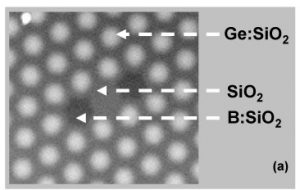
X Liu; J Lægsgaard; D Turchinovich
Highly-stable monolithic femtosecond Yb-fiber laser system based on photonic crystal fibers Journal Article
In: Opt. Express, vol. 18, pp. 15475, 2010.
@article{Liu2010b,
title = {Highly-stable monolithic femtosecond Yb-fiber laser system based on photonic crystal fibers},
author = {X Liu and J Lægsgaard and D Turchinovich},
doi = {https://doi.org/10.1364/OE.18.015475},
year = {2010},
date = {2010-07-07},
journal = {Opt. Express},
volume = {18},
pages = {15475},
abstract = {A self-starting, passively stabilized, monolithic all-polarization-maintaining femtosecond Yb-fiber master oscillator / power amplifier with very high operational and environmental stability is demonstrated. The system is based on the use of two different photonic crystal fibers. One is used in the oscillator cavity for dispersion balancing and nonlinear optical limiting, and another one is used for low-nonlinearity final pulse recompression. The chirped-pulse amplification and recompression of the 232-fs, 45-pJ/pulse oscillator output yields a final direct fiber-end delivery of 7.3-nJ energy pulses of around 297 fs duration. Our laser shows exceptional stability. No Q-switched modelocking events were detected during 4-days long observation. An average fluctuation of only 7.85 · 10−4 over the mean output power was determined as a result of more than 6-hours long measurement. The laser is stable towards mechanical disturbances, and maintains stable modelocking in the temperature range of at least 10 – 40 °C.
©2010 Optical Society of America},
keywords = {},
pubstate = {published},
tppubtype = {article}
}
©2010 Optical Society of America
M C Hoffmann; D Turchinovich
Semiconductor saturable absorbers for ultrafast terahertz signals Journal Article
In: Appl. Phys. Lett., vol. 96, pp. 151110, 2010.
@article{Hoffmann2010bb,
title = {Semiconductor saturable absorbers for ultrafast terahertz signals},
author = {M C Hoffmann and D Turchinovich},
doi = {https://doi.org/10.1063/1.3386542},
year = {2010},
date = {2010-04-15},
journal = {Appl. Phys. Lett.},
volume = {96},
pages = {151110},
abstract = {We demonstrate saturable absorber behavior of n-type semiconductors GaAs, GaP, and Ge in the terahertz (THz) frequency range at room temperature using nonlinear THz spectroscopy. The saturation mechanism is based on a decrease in electron conductivity of semiconductors at high electron momentum states, due to conduction band nonparabolicity and scattering into satellite valleys in strong THz fields. Saturable absorber parameters, such as linear and nonsaturable transmission, and saturation fluence, are extracted by fits to a classic saturable absorber model. Further, we observe THz pulse shortening, and an increase in the group refractive index of the samples at higher THz pulse peak fields.
We are grateful to Danish Advanced Technology Foundation (HTF) and Max Planck Society for financial support; and to A. Cavalleri (Univ. Hamburg), K. Yvind, J. Mørk, and J. M. Hvam (DTU Fotonik) for valuable assistance and discussions.},
keywords = {},
pubstate = {published},
tppubtype = {article}
}
We are grateful to Danish Advanced Technology Foundation (HTF) and Max Planck Society for financial support; and to A. Cavalleri (Univ. Hamburg), K. Yvind, J. Mørk, and J. M. Hvam (DTU Fotonik) for valuable assistance and discussions.
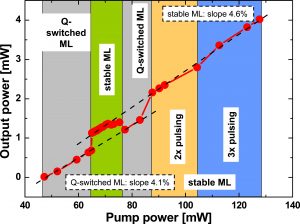
X Liu; J Lægsgaard; D Turchinovich
Self-stabilization of a mode-locked femtosecond fiber laser using a photonic bandgap fiber Journal Article
In: Opt. Lett., vol. 35, pp. 913, 2010.
@article{Liu2010cb,
title = {Self-stabilization of a mode-locked femtosecond fiber laser using a photonic bandgap fiber},
author = {X Liu and J Lægsgaard and D Turchinovich},
doi = {https://doi.org/10.1364/OL.35.000913},
year = {2010},
date = {2010-03-18},
journal = {Opt. Lett.},
volume = {35},
pages = {913},
abstract = {We demonstrate a self-stabilization mechanism of a semiconductor saturable absorber mode-locked linear-cavity Yb-doped fiber laser using an intracavity photonic bandgap fiber. This mechanism relies on the spectral shift of the laser pulses to a spectral range of higher anomalous dispersion and higher loss of the photonic bandgap fiber, as a reaction to the intracavity power buildup. This, in particular, results in a smaller cavity loss for the stably mode-locked laser, as opposed to the Q-switched mode-locking scenario. The laser provides stable 39–49 pJ pulses of around 230 fs duration at 29 MHz repetition rate.
© 2010 Optical Society of America},
keywords = {},
pubstate = {published},
tppubtype = {article}
}
© 2010 Optical Society of America
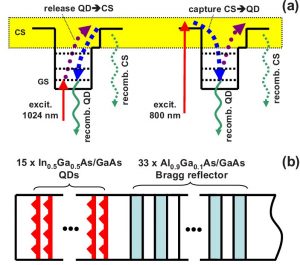
H P Porte; Uhd P Jepsen; N Daghestani; E U Rafailov; D Turchinovich
Ultrafast release and capture of carriers in InGaAs/GaAs quantum dots observed by time-resolved terahertz spectroscopy Journal Article
In: Appl. Phys. Lett., vol. 94, pp. 262104, 2009.
@article{Porte2009,
title = {Ultrafast release and capture of carriers in InGaAs/GaAs quantum dots observed by time-resolved terahertz spectroscopy},
author = {H P Porte and Uhd P Jepsen and N Daghestani and E U Rafailov and D Turchinovich},
doi = {https://doi.org/10.1063/1.3158958},
year = {2009},
date = {2009-06-29},
journal = {Appl. Phys. Lett.},
volume = {94},
pages = {262104},
abstract = {We observe ultrafast release and capture of charge carriers in InGaAs/GaAs quantum dots in a room-temperature optical pump-terahertz probe experiment sensitive to the population dynamics of conducting states. In case of resonant excitation of the quantum dot ground state, the maximum conductivity is achieved at approximately 35 ps after photoexcitation, which is assigned to release of carriers from the quantum dots. When exciting carriers into the conduction band of the barriers, depletion of the conductivity via carrier capture into the quantum dots with a few picosecond pump fluence-dependent time constant was observed.
We are grateful to the Danish Advanced Technology Foundation (HTF), and EU FP7 Programme (FAST-DOT), Grant No. 224338, for financial support; and to D. A. Livshits (Innolume GmbH), K. Iwaszczuk, D. G. Cooke, and J. M. Hvam (DTU Fotonik) for valuable assistance and discussions.},
keywords = {},
pubstate = {published},
tppubtype = {article}
}
We are grateful to the Danish Advanced Technology Foundation (HTF), and EU FP7 Programme (FAST-DOT), Grant No. 224338, for financial support; and to D. A. Livshits (Innolume GmbH), K. Iwaszczuk, D. G. Cooke, and J. M. Hvam (DTU Fotonik) for valuable assistance and discussions.

L Scolari; C B T Olausson; J Weirich; D Turchinovich; T T Alkeskjold; A Bjarklev; L Eskildsen
A tunable polarization maintaining filter based on a liquid crystal photonic bandgap fibre Journal Article
In: Electron. Lett., vol. 44, pp. 1189, 2008, ISSN: 1350-911X.
@article{Scolari2008,
title = {A tunable polarization maintaining filter based on a liquid crystal photonic bandgap fibre},
author = {L Scolari and C B T Olausson and J Weirich and D Turchinovich and T T Alkeskjold and A Bjarklev and L Eskildsen},
doi = {10.1049/el:20082164},
issn = {1350-911X},
year = {2008},
date = {2008-09-25},
journal = {Electron. Lett.},
volume = {44},
pages = {1189},
abstract = {A tunable and polarisation-maintaining all-in-fibre filter based on a liquid crystal photonic bandgap fibre is demonstrated. Its polarisation extinction ratio reaches 14 dB at 1550 nm wavelength. Its spectral tunability range spans over 250 nm in the temperature range 30–70°C. The measured transmission spectrum is compared with that obtained through finite element simulations.},
keywords = {},
pubstate = {published},
tppubtype = {article}
}
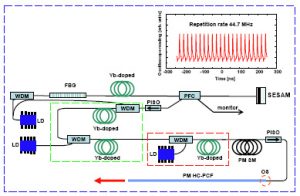
D Turchinovich; X Liu; J Lægsgaard
In: Opt. Express, vol. 16, pp. 14004, 2008.
@article{Turchinovich2008,
title = {Monolithic all-PM femtosecond Yb-fiber laser stabilized with a narrow-band fiber Bragg grating and pulse-compressed in a hollow-core photonic crystal fiber},
author = {D Turchinovich and X Liu and J Lægsgaard},
doi = {https://doi.org/10.1364/OE.16.014004},
year = {2008},
date = {2008-08-25},
journal = {Opt. Express},
volume = {16},
pages = {14004},
abstract = {We report on an environmentally stable self-starting monolithic (i.e. without any free-space coupling) all-polarization-maintaining (PM) femtosecond Yb-fiber laser, stabilized against Q-switching by a narrowband fiber Bragg grating and modelocked using a semiconductor saturable absorber mirror. The laser output is compressed in a spliced-on hollow-core PM photonic crystal fiber, thus providing direct end-of-the-fiber delivery of pulses of around 370 fs duration and 4 nJ energy with high mode quality. Tuning the pump power of the end amplifier of the laser allows for the control of output pulse bandwidth and duration. Our experimental results are in good agreement with the theoretical predictions.
©2008 Optical Society of America},
keywords = {},
pubstate = {published},
tppubtype = {article}
}
©2008 Optical Society of America
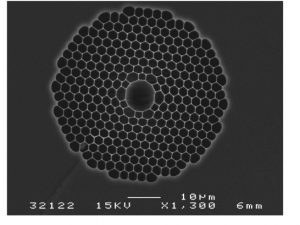
J T Kristensen; A Houmann; X Liu; D Turchinovich
In: Opt. Express, vol. 16, pp. 9986, 2008.
@article{Kristensen2008,
title = {Low-loss polarization-maintaining fusion splicing of single-mode fibers and hollow-core photonic crystal fibers, relevant for monolithic fiber laser pulse compression},
author = {J T Kristensen and A Houmann and X Liu and D Turchinovich},
doi = {https://doi.org/10.1364/OE.16.009986},
year = {2008},
date = {2008-06-20},
journal = {Opt. Express},
volume = {16},
pages = {9986},
abstract = {We report on highly reproducible low-loss fusion splicing of polarization-maintaining single-mode fibers (PM-SMFs) and hollow-core photonic crystal fibers (HC-PCFs). The PM-SMF-to-HC-PCF splices are characterized by the loss of 0.62±0.24 dB, and polarization extinction ratio of 19±0.68 dB. The reciprocal HC-PCF-to-PM-SMF splice loss is found to be 2.19±0.33 dB, which is caused by the mode evolution in HC-PCF. The return loss in both cases was measured to be -14 dB. We show that a splice defect is caused by the HC-PCF cleave defect, and the lossy splice can be predicted at an early stage of the splicing process. We also demonstrate that the higher splice loss compromises the PM properties of the splice. Our splicing technique was successfully applied to the realization of a low-loss, environmentally stable monolithic PM fiber laser pulse compressor, enabling direct end-of-the-fiber femtosecond pulse delivery.
©2008 Optical Society of America},
keywords = {},
pubstate = {published},
tppubtype = {article}
}
©2008 Optical Society of America

D Turchinovich; J I Dijkhuis
Performance of combined <100>-<110> ZnTe crystals in an amplified THz time-domain spectrometer Journal Article
In: Opt. Commun., vol. 270, pp. 96, 2007.
@article{Turchinovich2006c,
title = {Performance of combined <100>-<110> ZnTe crystals in an amplified THz time-domain spectrometer},
author = {D Turchinovich and J I Dijkhuis},
doi = {https://doi.org/10.1016/j.optcom.2006.08.045},
year = {2007},
date = {2007-02-01},
journal = {Opt. Commun.},
volume = {270},
pages = {96},
abstract = {In this work we report on the performance of combined index-matched ZnTe 〈1 1 0〉–〈1 0 0〉 THz emitters and detectors for reduction of etalon effects in a nonlinear crystal-based THz time-domain spectrometer, driven by an amplified femtosecond laser. We demonstrate that the application of a combined electrooptic detector crystal reduces the strength of the first etalon and the average spectral dynamic range oscillations by a factor of two. We also show that even in a simple emitter configuration the emitter-related etalon is significantly reduced due to the transient dielectric effects of carriers created by two-photon absorption in the emitter.},
keywords = {},
pubstate = {published},
tppubtype = {article}
}
D Turchinovich; Uhd P Jepsen
Nonlinear excitation kinetics of biased quantum wells. Coherent dynamical screening effect Journal Article
In: Phys. stat. sol. (c), vol. 3, pp. 2494, 2006.
@article{Turchinovich2006b,
title = {Nonlinear excitation kinetics of biased quantum wells. Coherent dynamical screening effect},
author = {D Turchinovich and Uhd P Jepsen},
doi = {https://doi.org/10.1002/pssc.200668102},
year = {2006},
date = {2006-07-25},
journal = {Phys. stat. sol. (c)},
volume = {3},
pages = {2494},
abstract = {In this paper we describe a strongly nonlinear process of ultrafast photoexcitation of a biased quantum well. This process is governed by coherent dynamical screening, where the instantaneously polarized photoexcited carriers screen initial bias field. This results in a dynamic modification of the bandstructure of the quantum well, which is totally coherent with the temporal intensity distribution in the excitation laser pulse. We developed a time‐resolved theoretical model of coherent dynamical screening, which predicts interesting fundamental consequences, such as nonlinear absorption and ultra‐broadband THz emission. The results of our THz and optical experiments are in good agreement with the theoretical model. (© 2006 WILEY‐VCH Verlag GmbH & Co. KGaA, Weinheim)},
keywords = {},
pubstate = {published},
tppubtype = {article}
}
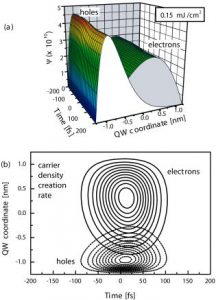
D Turchinovich; B S Monozon; Uhd P Jepsen
Role of dynamical screening in excitation kinetics of biased quantum wells: Nonlinear absorption and ultrabroadband terahertz emission Journal Article
In: J. Appl. Phys., vol. 99, pp. 013510, 2006.
@article{Turchinovich2006cb,
title = {Role of dynamical screening in excitation kinetics of biased quantum wells: Nonlinear absorption and ultrabroadband terahertz emission},
author = {D Turchinovich and B S Monozon and Uhd P Jepsen},
doi = {https://doi.org/10.1063/1.2150256},
year = {2006},
date = {2006-01-06},
journal = {J. Appl. Phys.},
volume = {99},
pages = {013510},
abstract = {In this work we describe the ultrafast excitation kinetics of a biased quantum well, arising from the optically induced dynamical screening of a bias electric field. The initial bias electric field inside the quantum well is screened by the optically excited polarized electron-hole pairs. This leads to a dynamical modification of the properties of the system within an excitation pulse duration. We calculate the excitation kinetics of a biased quantum well and the dependency of resulting electronic and optical properties on the excitation pulse fluence, quantum well width, and initial bias field strength. Our calculations, in particular, predict the strongly nonlinear dependency of the effective optical absorption coefficient on the excitation pulse fluence, and ultrabroadband terahertz emission. Our theoretical model is free of fitting parameters. Calculations performed for internally biased InGaN∕GaN quantum wells are in good agreement with our experimental observations [Turchinovich et al., Phys. Rev. B 68, 241307(R) (2003)], as well as in perfect compliance with qualitative considerations.},
keywords = {},
pubstate = {published},
tppubtype = {article}
}
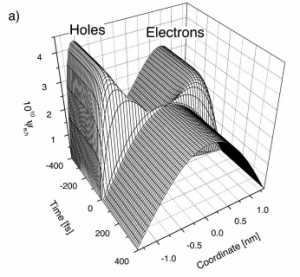
D Turchinovich; B S Monozon; Uhd P Jepsen
Ultrafast polarization dynamics in biased quantum wells under strong femtosecond optical excitation Journal Article
In: Phys. Rev. B, vol. 68, pp. 241307, 2003.
@article{Turchinovich2003b,
title = {Ultrafast polarization dynamics in biased quantum wells under strong femtosecond optical excitation},
author = {D Turchinovich and B S Monozon and Uhd P Jepsen},
doi = {https://doi.org/10.1103/PhysRevB.68.241307},
year = {2003},
date = {2003-12-22},
journal = {Phys. Rev. B},
volume = {68},
pages = {241307},
abstract = {We observe ultrafast polarization dynamics in strongly internally biased InGaN/GaN multiple quantum wells during intense femtosecond optical excitation. In the case of strong enough excitation we demonstrate that the built-in bias field (on the order of MV/cm) can be completely screened by the carriers excited in spatially separated states. The removal of the initial strong bias leads to dynamical modification of the band structure, the electron and hole wave functions, and the absorption coefficient within the duration of the excitation pulse. We show that such an optically induced dynamical screening of the biased quantum well can be described in terms of discharging of a nanoscale capacitor driven by a femtosecond laser pulse. The electrostatic energy stored in the capacitor is released via THz emission. Due to its nonlinearity such a process may lead to emission of a THz pulse with bandwidth significantly exceeding that of the excitation pulse.},
keywords = {},
pubstate = {published},
tppubtype = {article}
}
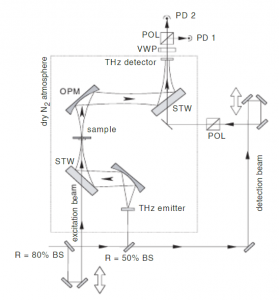
D Turchinovich; K Pierz; P.Uhd Jepsen
InAs/GaAs quantum dots as efficient free carrier deep traps Journal Article
In: phys. stat. sol. (c), vol. 0, pp. 1556, 2003.
@article{Turchinovich2003bb,
title = {InAs/GaAs quantum dots as efficient free carrier deep traps},
author = {D Turchinovich and K Pierz and P.Uhd Jepsen},
doi = {https://doi.org/10.1002/pssc.200303230},
year = {2003},
date = {2003-08-04},
journal = {phys. stat. sol. (c)},
volume = {0},
pages = {1556},
abstract = {The results of optical‐pump THz‐probe experiment on InAs/GaAs quantum dot structures are discussed in this paper. In InAs/GaAs quantum dot strutures the free carrier lifetime is observed to be substantially shorter than that in bulk GaAs, especially at weak pump powers. We attribute this behaviour mainly to the trapping of free carriers into the quantum dots.},
keywords = {},
pubstate = {published},
tppubtype = {article}
}
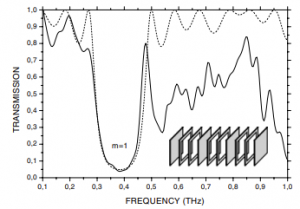
D Turchinovich; A Kammoun; P Knobloch; T Dobbertin; M Koch
Flexible all-plastic mirrors for the THz range Journal Article
In: Appl. Phys. A, vol. 74, pp. 291, 2002.
@article{Turchinovich2002,
title = {Flexible all-plastic mirrors for the THz range},
author = {D Turchinovich and A Kammoun and P Knobloch and T Dobbertin and M Koch},
doi = {https://doi.org/10.1007/s003390101036},
year = {2002},
date = {2002-02-02},
journal = {Appl. Phys. A},
volume = {74},
pages = {291},
abstract = {We present a simple and cheap approach to fabricate large-area stop-band filters and mirrors for the THz range. This approach extends the well-known concept of dielectric mirrors to the far infrared. We use alternating layers of different polymer materials with a typical thickness of several tens of micrometers to build a flexible all-plastic mirror. The structures are characterized by THz time-domain spectroscopy. The experimental results are in good agreement with transfer-matrix simulations.},
keywords = {},
pubstate = {published},
tppubtype = {article}
}
W Ossau; V P Kochereshko; D R Yakovlev; R A Suris; D Turchinovich; G Landwehr; T Wojtowicz; G Karczewski; J Kossut
Exciton-electron interactions in modulation-doped QW structures Journal Article
In: Phys. Low-Dim. Struct., vol. 1/2, pp. 205, 1998.
@article{Ossau1998,
title = {Exciton-electron interactions in modulation-doped QW structures},
author = {W Ossau and V P Kochereshko and D R Yakovlev and R A Suris and D Turchinovich and G Landwehr and T Wojtowicz and G Karczewski and J Kossut},
year = {1998},
date = {1998-11-01},
journal = {Phys. Low-Dim. Struct.},
volume = {1/2},
pages = {205},
keywords = {},
pubstate = {published},
tppubtype = {article}
}
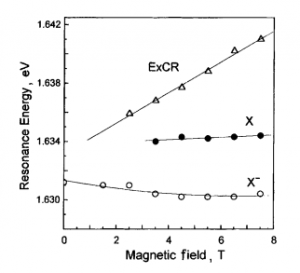
D B Turchinovich; V P Kochereshko; D R Yakovlev; W Ossau; G Landwehr; T Wojtowicz; G Karczewski; J Kossut
Trions in quantum-well structures with two-dimensional electron gas Journal Article
In: Phys. Solid State, vol. 40, pp. 747, 1998.
@article{Turchinovich1998,
title = {Trions in quantum-well structures with two-dimensional electron gas},
author = {D B Turchinovich and V P Kochereshko and D R Yakovlev and W Ossau and G Landwehr and T Wojtowicz and G Karczewski and J Kossut},
doi = {https://doi.org/10.1134/1.1130439},
year = {1998},
date = {1998-05-01},
journal = {Phys. Solid State},
volume = {40},
pages = {747},
abstract = {A study has been made of bound exciton-electron complexes (trions) and unbound exciton-electron states (combined exciton-cyclotron resonance) from reflectance spectra obtained from modulation-doped CdTe/CdMgTe quantum-well structures. It has been established that the contribution of trions to dielectric permittivity is comparable to that of excitons. An analysis is made of the magnetic-field dependence of the parameters describing the contribution to dielectric permittivity due to exciton-cyclotron-resonance states.},
keywords = {},
pubstate = {published},
tppubtype = {article}
}
